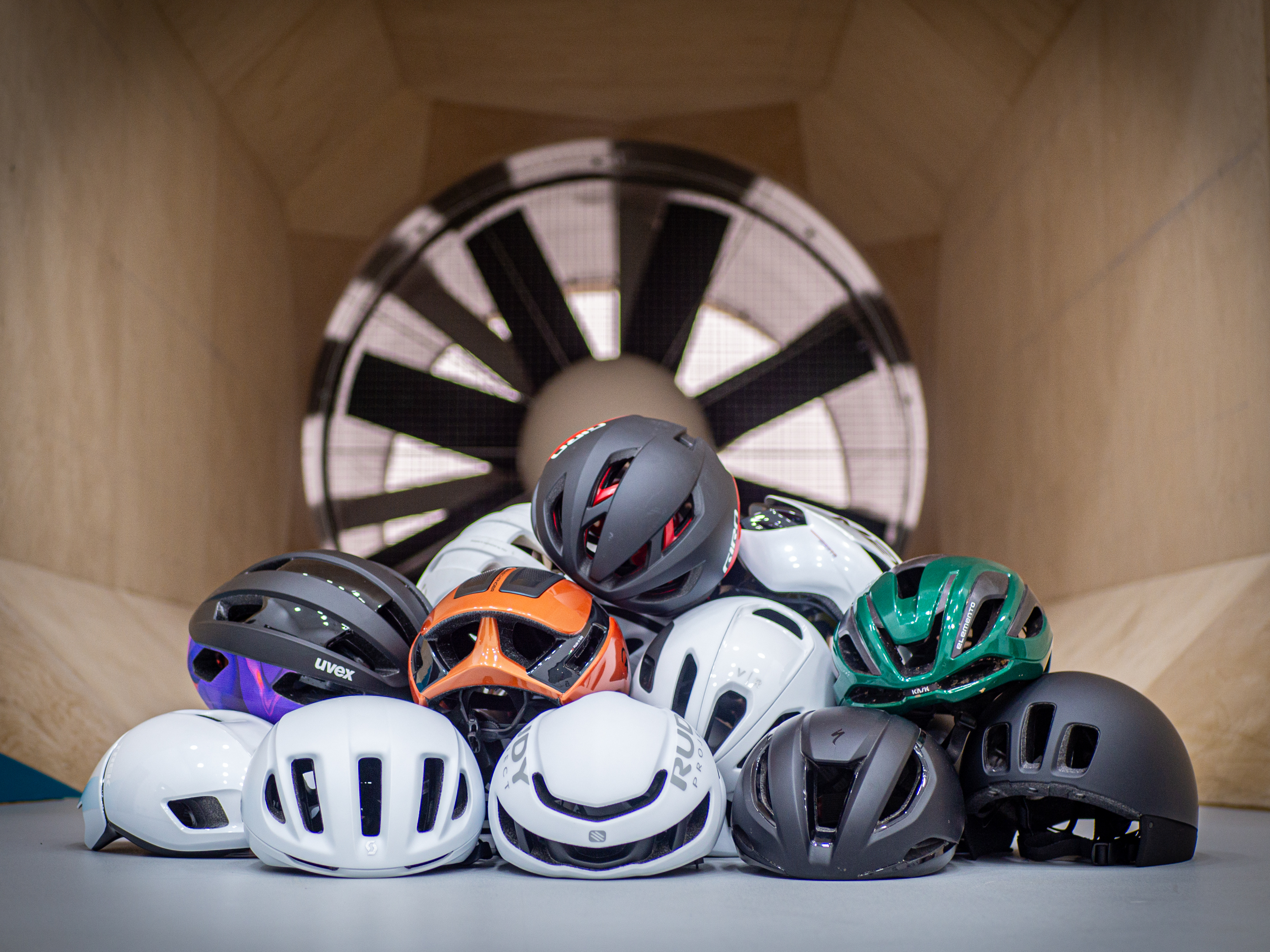
When buying a road bike helmet, your primary motivation most likely relates to safety. In the event of a crash, the added protection offered by a certified helmet can be the difference between walking away with little more than your ego bruised and, well, not walking away at all.
But there isn't a simple answer to whether one helmet is safer than the next. There are a select few third parties that perform independent tests, but at an industry level, all we know is that they've met the relevant local authority's minimum standard, which, brands tell us, is a low bar.
1. Poc Procen Air (w/ Visor)
2. Specialized S-Works Evade III
3. POC Procen Air w/out Visor
4. Scott Cadence
5. Van Rysel FCR
6. Giro Eclipse
7. Trek Ballista
8. Trek Velocis
9. Julbo Sprint
10. Kask Utopia Y
11. Lazer Vento Kineticore
12. MET Manta
13. Smith Ignite
14. Sweet Protection Tucker 2VI
15. Kask Elemento
16. Limar Air Atlas
17. Abus Gamechanger 2.0
18. Oakley ARO7 w/out Visor
19. Carnac Evo
20. Specialized S-Works Prevail III
21. Rudy Project Nytron
22. Oakley ARO7 w/ Visor
23. Uvex Rise Pro
24. POC Ventral Tempus
25. POC Ventral
As a result, choosing which helmet to buy is often a balance of other factors. Ventilation is important for those who live in warmer climates. Weight will be a key factor for mountain goats who spend their lives riding uphill. The fashion-conscious will prioritise how it looks, but for the majority of us, the important metric will be aerodynamics. Who doesn't want to go faster for less effort?
Around a decade ago, the category of aero road helmets sprung into life, and these days some take an unambiguously aero approach to their design, with long tails and closed-off frontal profiles. Others take a more subtle approach, with a more rounded rear and a few vents up front.
Given their go-faster intentions, it's not uncommon for an aero helmet to be launched with claims of being some watts more aerodynamic than that other helmet, or any number of seconds faster than something else over a 40km time trial. Those comparisons usually relate to a brand's outgoing model or other products in the lineup; rarely will they call out the competition.
As a result, there isn't much information out there that compares across brands, such as the Specialized Evade against the Trek Ballista, or the Met Manta against the Giro Eclipse.
Luckily, that's where we come in!
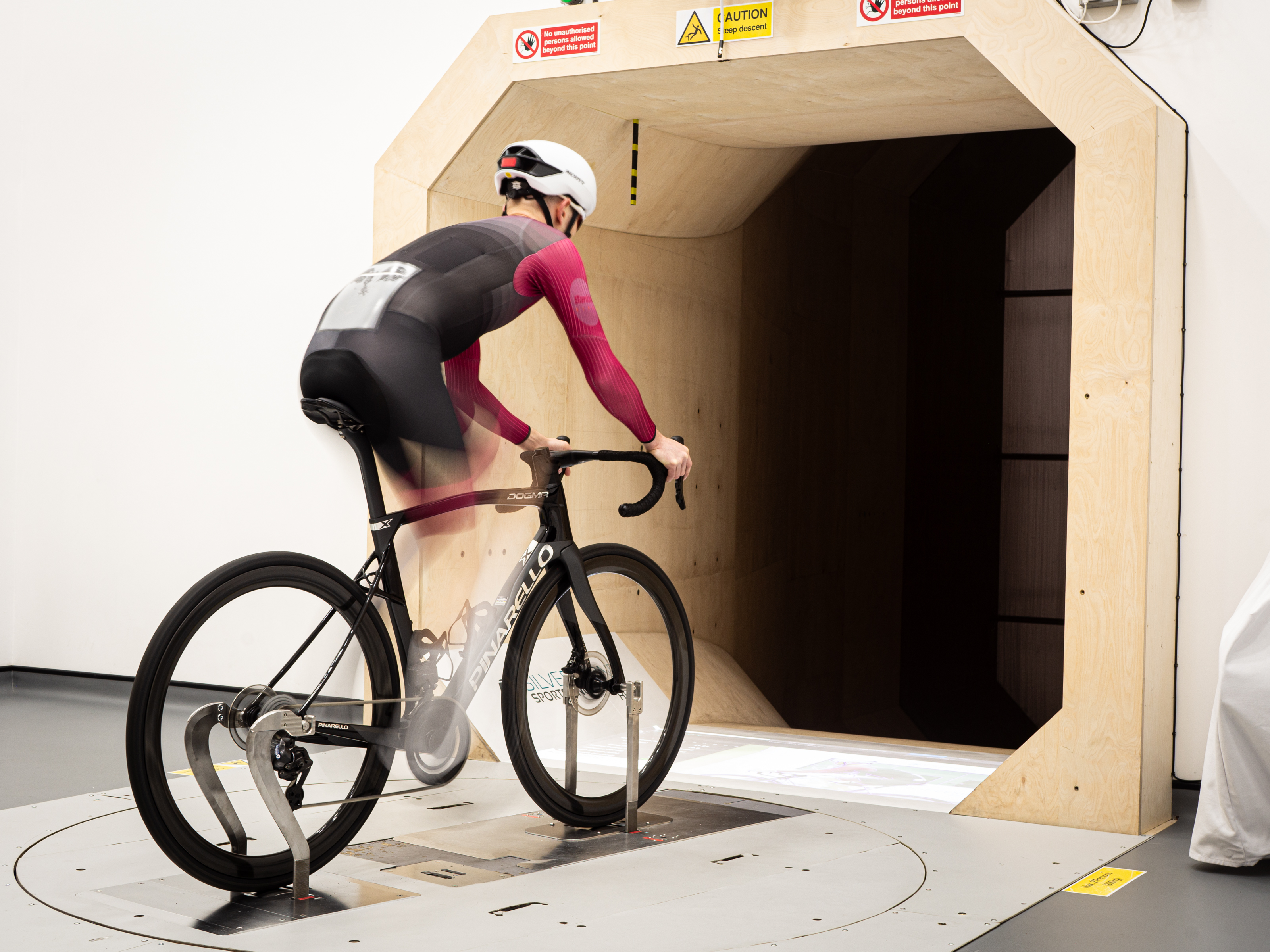
We took 23* different helmets from 18 brands to the wind tunnel for a back-to-back test to find out which was fastest (and which was slowest!). We also ran some additional tests on sunglasses, gloves and more, which we'll share in the coming weeks.
*We actually took 24 helmets, but one was an unreleased helmet that launches later this year. We tested it under the promise of keeping the results to ourselves until then. I'm afraid that's all you'll hear about it until it does.
Before we get into the data, a quick interlude to say that this feature is not sponsored and we paid the normal commercial rate for our wind tunnel access. This content was made possible solely and entirely by our paying subscribers.
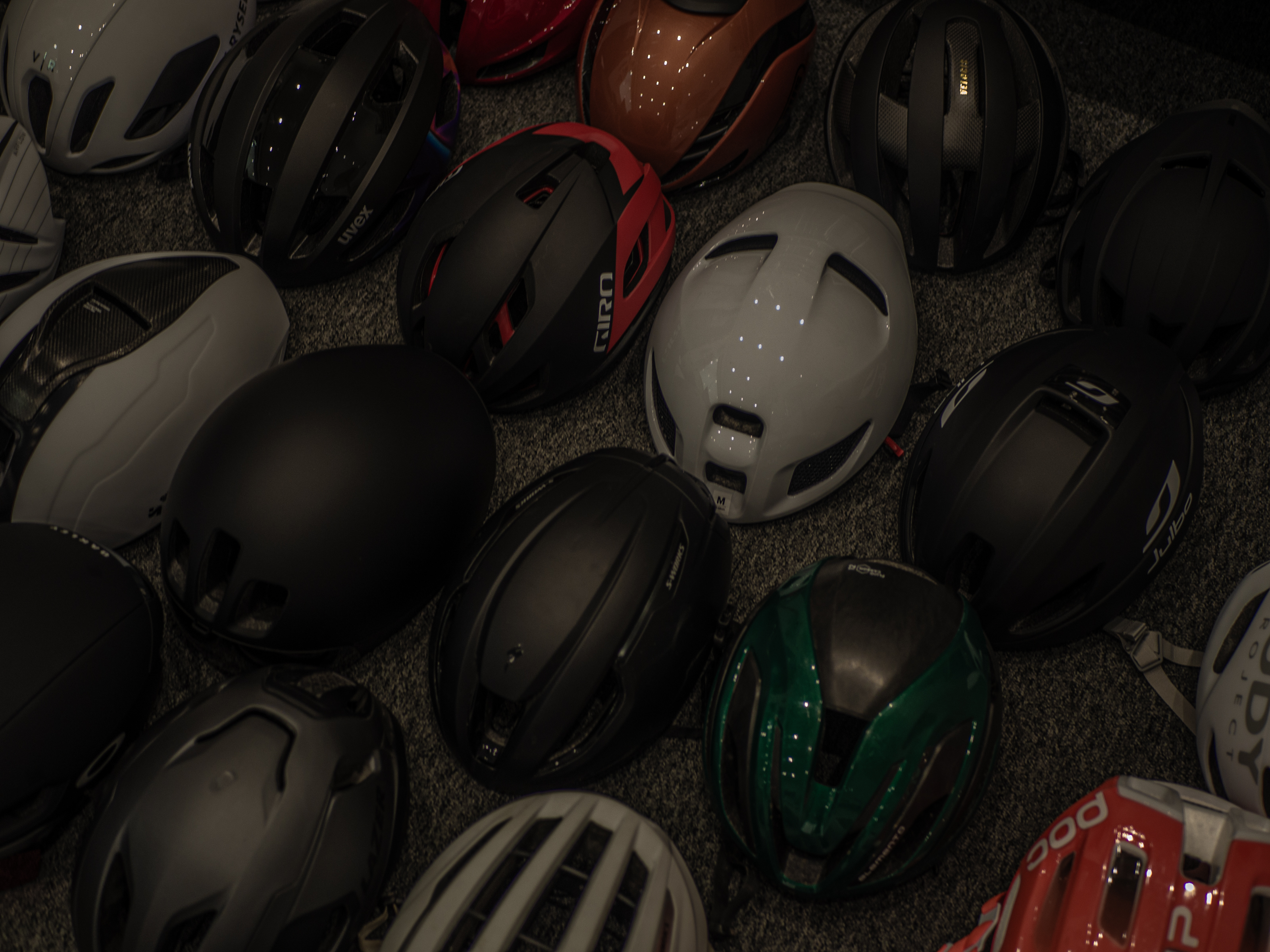
The helmets
Of all the helmets we took, the majority were described as aero helmets by their respective brand and fell somewhere on the spectrum between 'all-out aero' (such as the Trek Ballista or S-Works Evade) and 'aero all-rounder' (like the Giro Eclipse or POC Ventral).
A small number would be classed as 'vented' helmets, because we also wanted to get a feel for the difference between the 'vented' and 'aero' categories as collectives. In alphabetical order, they are as follows:
Aero helmets
- ABUS Gamechanger
- Carnac Evo
- Giro Eclipse
- Julbo Sprint
- Kask Elemento
- Kask Utopia Y
- Lazer Vento Kineticore
- Limar Air Atlas
- MET Manta
- Oakley ARO7 (tested twice - with and without visor)
- POC Procen Air (tested twice - with and without visor)
- POC Ventral
- POC Ventral Tempus
- Rudy Project Nytron
- Scott Cadence
- Smith Ignite
- Specialized S-Works Evade III
- Sweet Protection Tucker 2VI
- Trek Ballista
- Van Rysel FCR
Vented helmets
- Specialized S-Works Prevail III
- Trek Velocis
- Uvex Rise Pro
Each helmet was size medium.
The decision process for choosing which helmets to test was based on our research of each brand's best available option(s) on the market at the time of testing; what's being used in the WorldTour; and which helmets we think people will consider when deciding to buy.
It was limited, to a point, by what we could get our hands on. For example, we wanted to include the Ekoi Aerodinamica but our multiple attempts to contact the brand went unanswered. We also tried to get the new Kask helmet (the one that goes down over the ears), but neither Kask nor Ineos had a spare they could loan us.
The test
We took the helmets to the wind tunnel at the Silverstone Sports Engineering Hub, testing the aerodynamic performance of each helmet.
Naturally, the test was standardised, meaning the same conditions were met for each data capture. These included the same bike (Pinarello Dogma X), rider, kit (Santini Viper skinsuit, Velotoze overshoes, Oakley Radar glasses), wind speed and more.
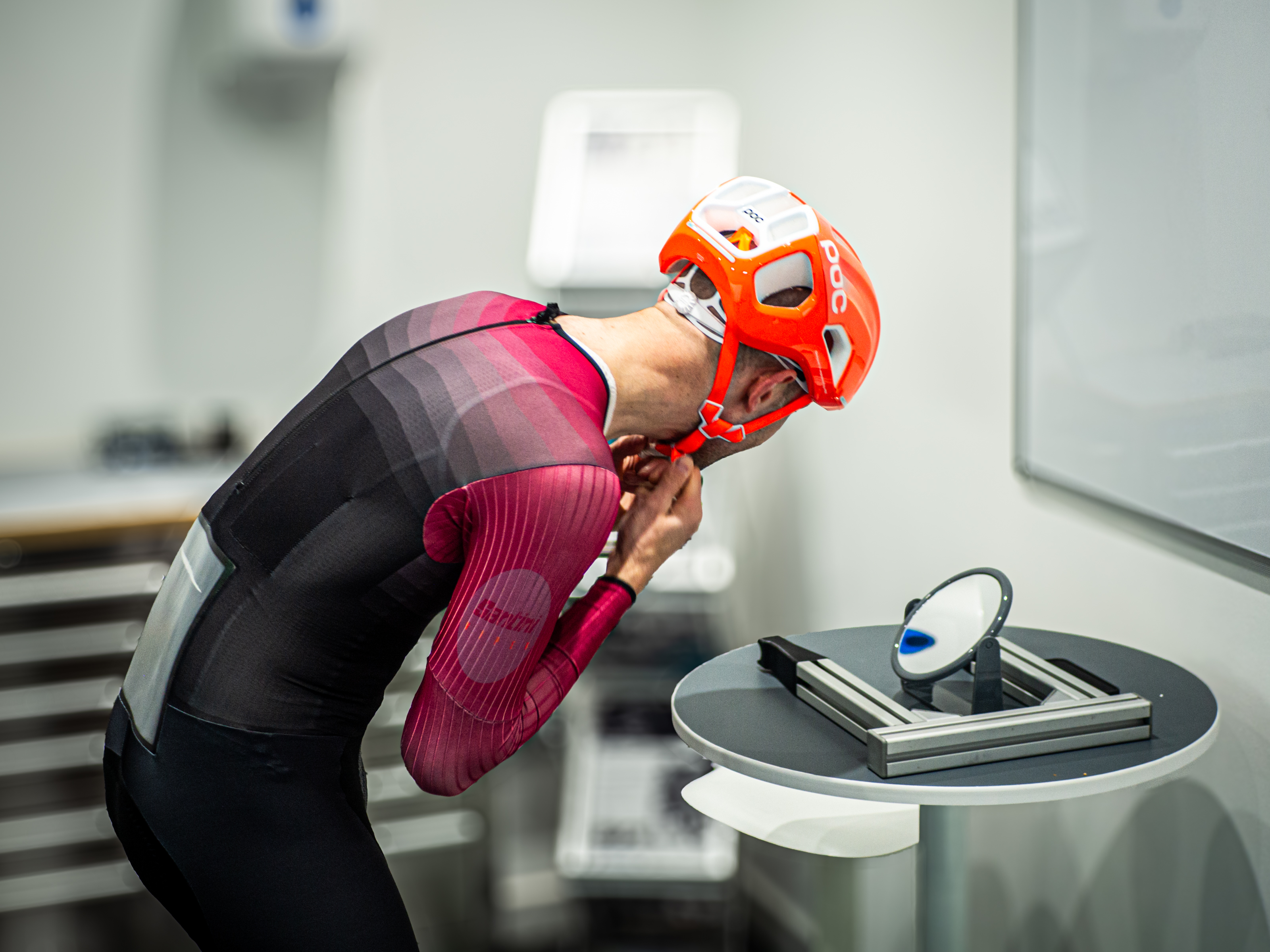
We ensured each helmet was sitting level before each run, and the straps for each helmet were clean against our model's face without any strap 'tail' (which could flap and skew the results). The wind tunnel itself was also put through a taring process before each capture to ensure accuracy.
The protocol was designed by myself, with guidance from aero experts Casper von Folsach in the run-up and Huw Williams on the day.
Pedalling the bike was Cyclingnews Tech Writer and amateur racer, Tom Wieckowski. We wanted to try and get as close to a real rider as possible, so we accepted the (financial) cost of running longer captures with a real person to get a more realistic result, rather than using a static mannequin.
Tom's position on the bike was captured in an initial baseline test, and then an outline of that position was projected onto the floor in front of him for the rest of the day. This provided an accurate cue for Tom to remain in position during subsequent runs. We also tested for positional drift, which comprised multiple tests with the same helmet to work out how much difference there could be between two identical setups, and thus how much blur we should accept in our results.
We tested each helmet at 40km/h (24.85mph). This is reflective of good amateur-level racing speeds, but the resulting CdA data will be valuable at all speeds. In the results below, I have extrapolated the data to provide the power required at 30, 40 and 50km/h, the speed expected at 250, 350 and 450 watts, and how those speeds relate to a 40km time trial.
Each data capture was performed in five-degree increments from 0 to +15 degrees yaw. That means four capture points of 0, +5, +10 and +15 degrees. Helmets are symmetrical, so there was no need to capture the data at negative yaw angles too. Each helmet was tested in a sweep in the same positive direction (0 to 15) for consistency and held for 30 seconds per capture.
The wind tunnel itself was operated by professional Engineering Technician Huw Williams and is designed to account for any changes in temperature or air density in its results.
Holding the bike in place was a set of stanchions, and no corrections were made for these, since they were the same across all tests. We're primarily interested in the difference between helmets here, not the absolute values.
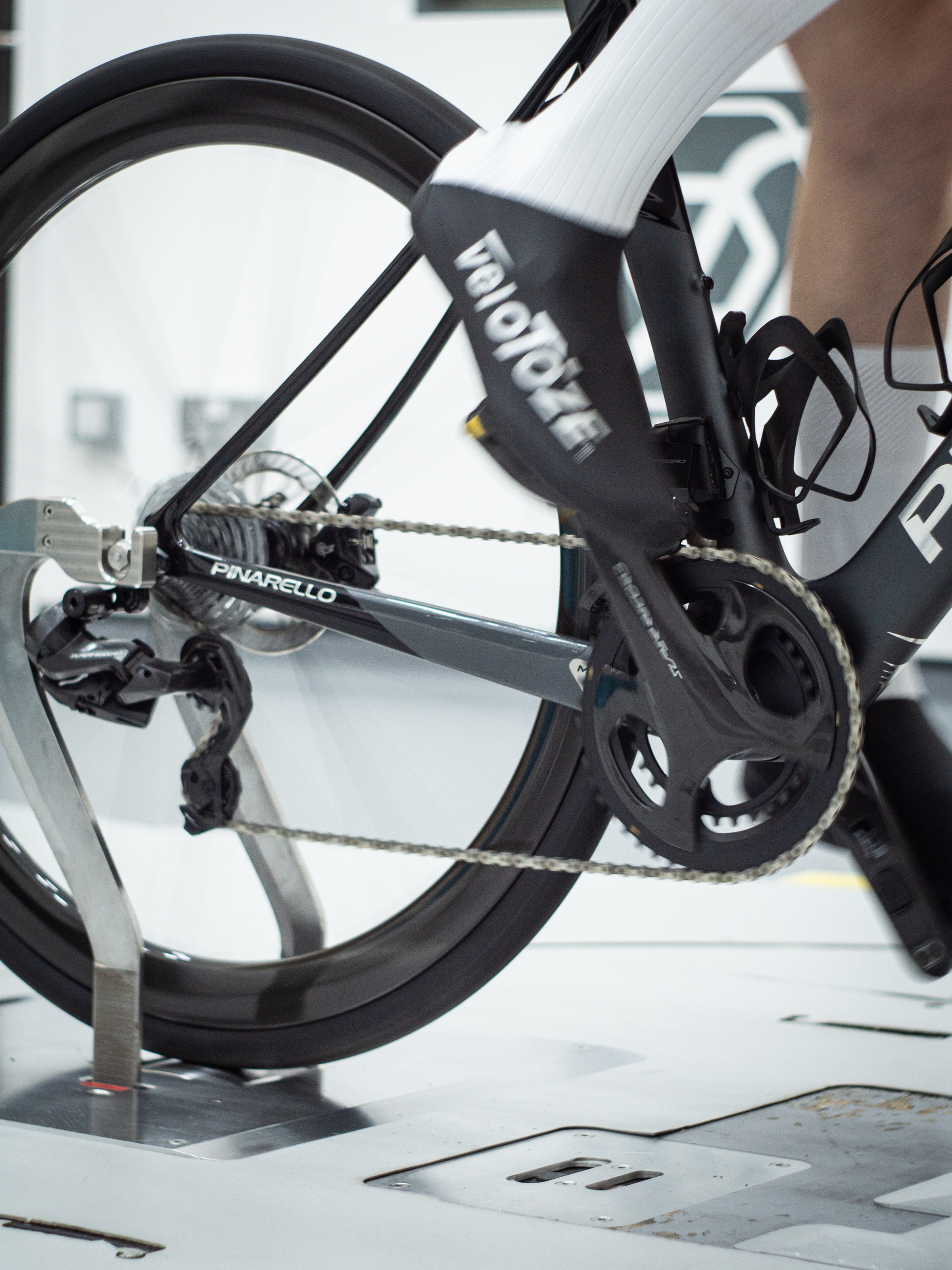
Some caveats
We've tested the aerodynamics here, so we have the CdA figure for each helmet at four different angles of yaw. With the average figure, we've done some calculations to solve for power (watts) at different speeds, for speed at different powers, and the time saved over a 40km course where all other factors remain equal. These calculations do not factor in additional losses such as drivetrain friction or rolling resistance, but we're only interested in the differences here, rather than absolute values.
Our rider Tom's positional drift equated to 1.19%. As a result, each result within 1.19% of another should bear this in mind, as it could simply be a result of this. We will continue to share the testing results as they were received for simplicity.
The results of our testing are representative of just that: our testing. We understand that helmet brands might see different results based on different tests or different protocols. We don't intend to claim that our results are the final word in helmet aero testing, but rather an additional stream of independent, unbiased testing and information for Cyclingnews readers.
We understand that the aerodynamic performance of a helmet can differ from person to person depending on how it interacts with the body. We sat Tom in a reasonably relaxed 'hoods' position, reflecting an all-day riding position, so that the helmet would sit higher away from his body to minimise this connection.
We also understand that there are other factors that come into play when buying an aero road bike helmet. For example, how well it will protect you in the event of a crash, how comfortable it is, its ventilation properties, its weight, its style, and how well it plays with glasses are just some of the other factors you should consider when deciding which to choose.
The results
For each helmet, we will list the CdA for all four yaw angles, along with the average and an accompanying line graph. We will order the helmets using the average from fastest to slowest.
We will then use it to calculate the power required to ride at 30km/h (18.64mph), 40km/h (24.85mph), and 50km/h (31.07mph) using the following calculation:
Power (watts) = 0.5 x AirDensity x CdA x Velocity^3
Where velocity = Metres per second
We will also calculate the expected speed if riding at 250 watts and 350 watts using the following calculation:
Speed (km/h) = 3.6 x ((Power / (0.5 x AirDensity x CdA)) ^⅓)
We will then apply this speed to calculate how long it would take to cover a 40km course. The calculation for this assumes ideal conditions and so factors such as wind, elevation, cornering, drivetrain efficiency, rolling resistance, acceleration, etc are all totally equal. Again, we're highlighting the differences here, we're not interested in absolute values.
The results in brief
Detailed results, ordered by average CdA
1. Poc Procen Air (w/ Visor)
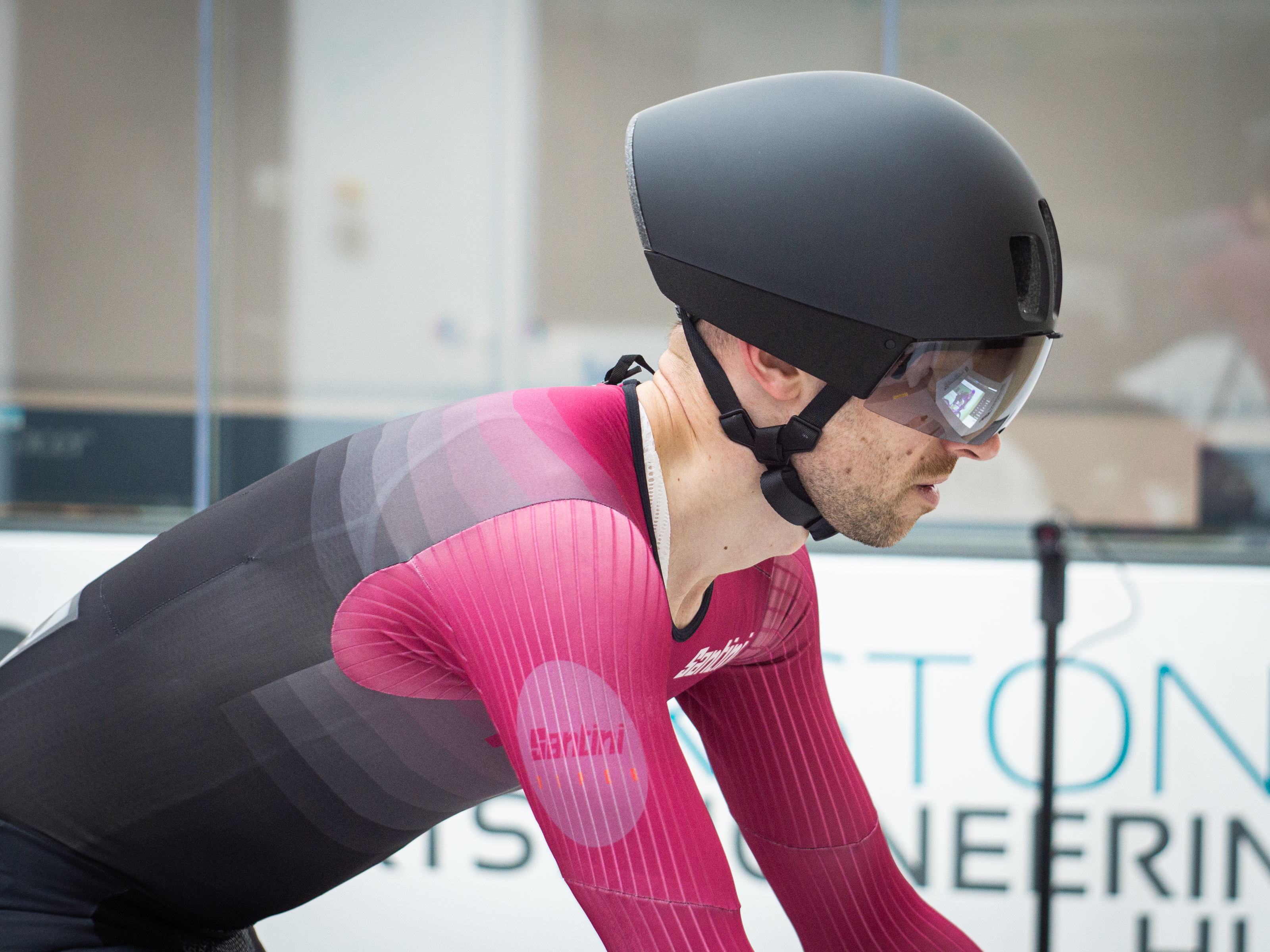
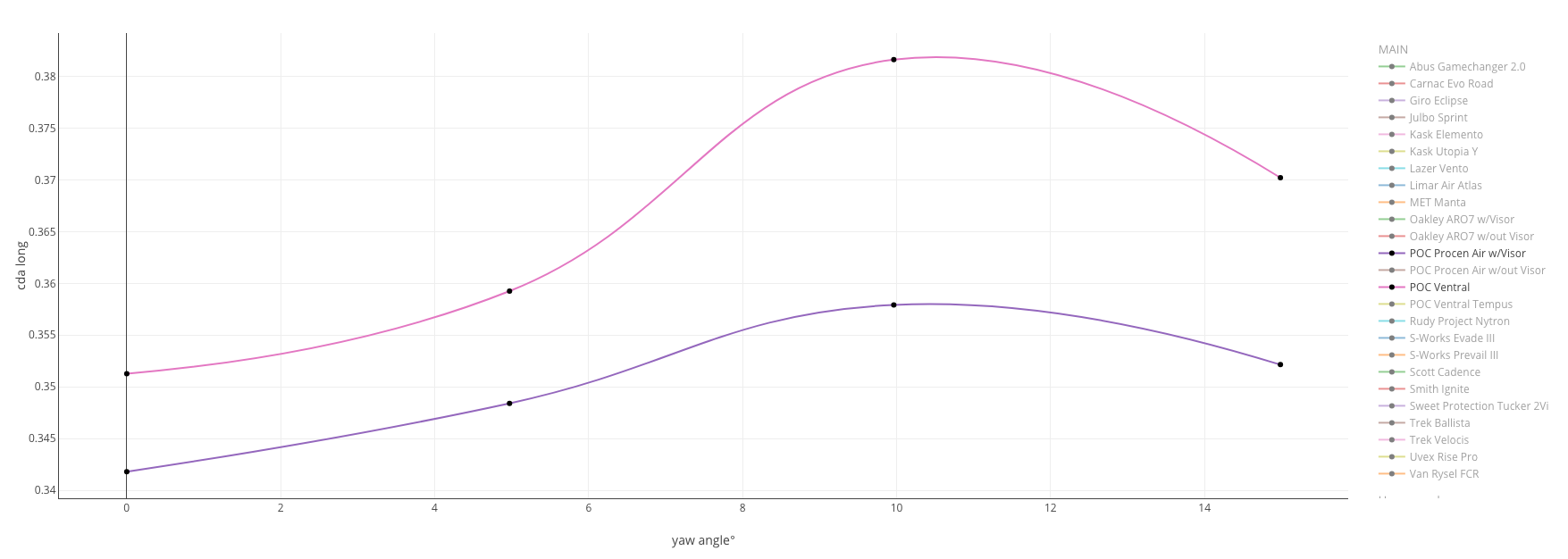
The winner of the Cyclingnews wind tunnel aero helmets test, when you consider the average CdA across the four yaw angles, is the POC Procen Air complete with visor.
It's the helmet that the EF Education-EasyPost men's team and EF Education-Cannondale women's team have been using in the WorldTour this season, and was designed in conjunction with riders from the team.
It's unsurprising because the Procen Air is probably better described as a time trial helmet adapted for the road. Aesthetically, it doesn't conform to what most people would describe as an aero helmet, and to be totally honest, you might feel a little bit silly if you turned up to a local club ride wearing one.
If you were to hold 250 watts for a 40km time trial, it would save you 55 seconds compared to the slowest helmet in our test, or if you were to ride at 40km/h, it would save you 12.76 watts.
On average, it is seven seconds faster over 40km than the 2nd place S-Works Evade III when riding at 250w. It is also 10 seconds faster with the visor than without it.
However, when you look closer at the CdA data at the specific yaw angles, the winning margin becomes a little more blurred. At both 0 degrees of yaw (ie no crosswind at all) and 15 degrees of yaw (quite a lot of crosswind), the Procen Air performs excellently, but in between at 5 and 10 degrees, the S-Works Evade III edges ahead.
2. Specialized S-Works Evade III
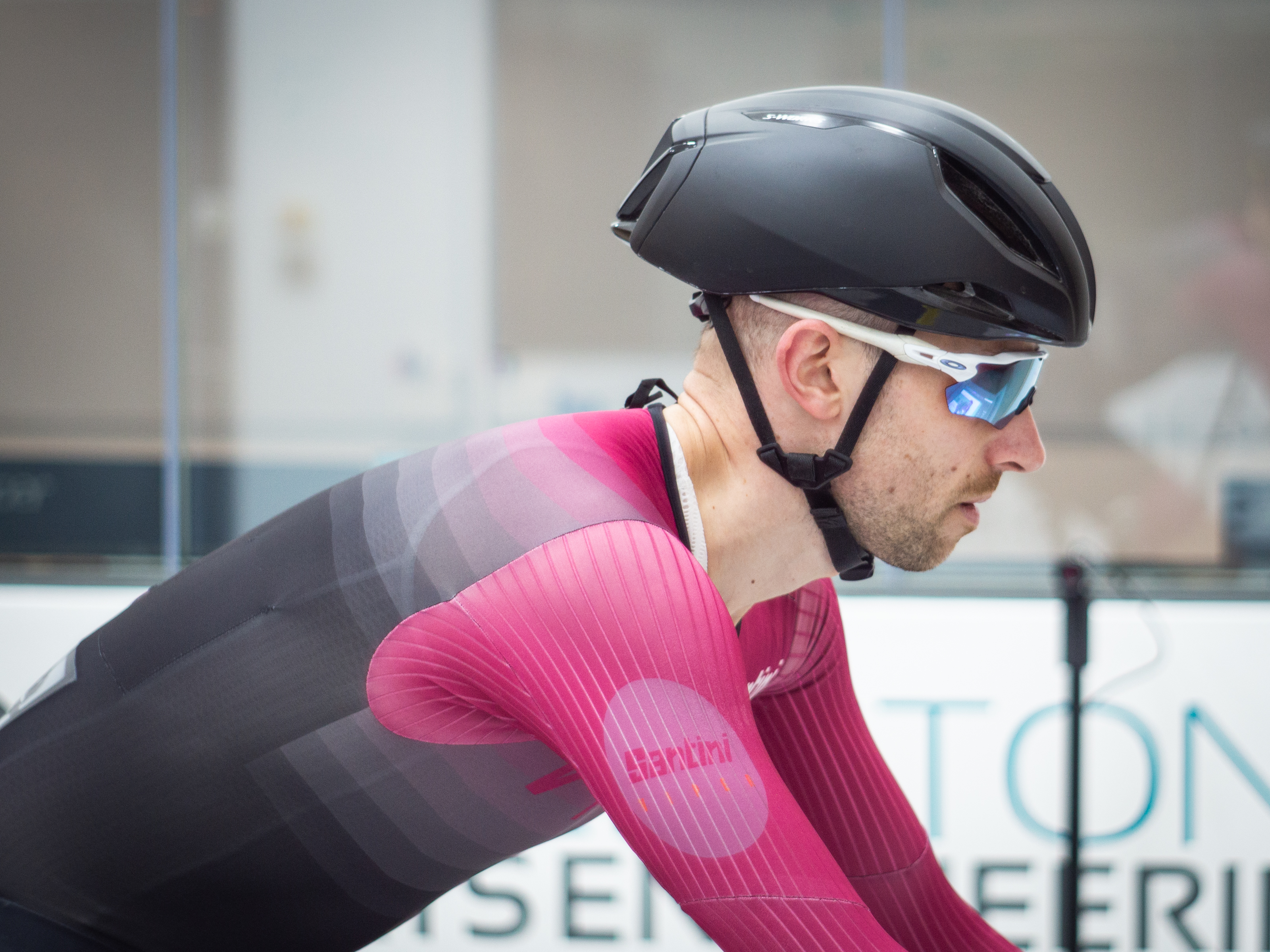
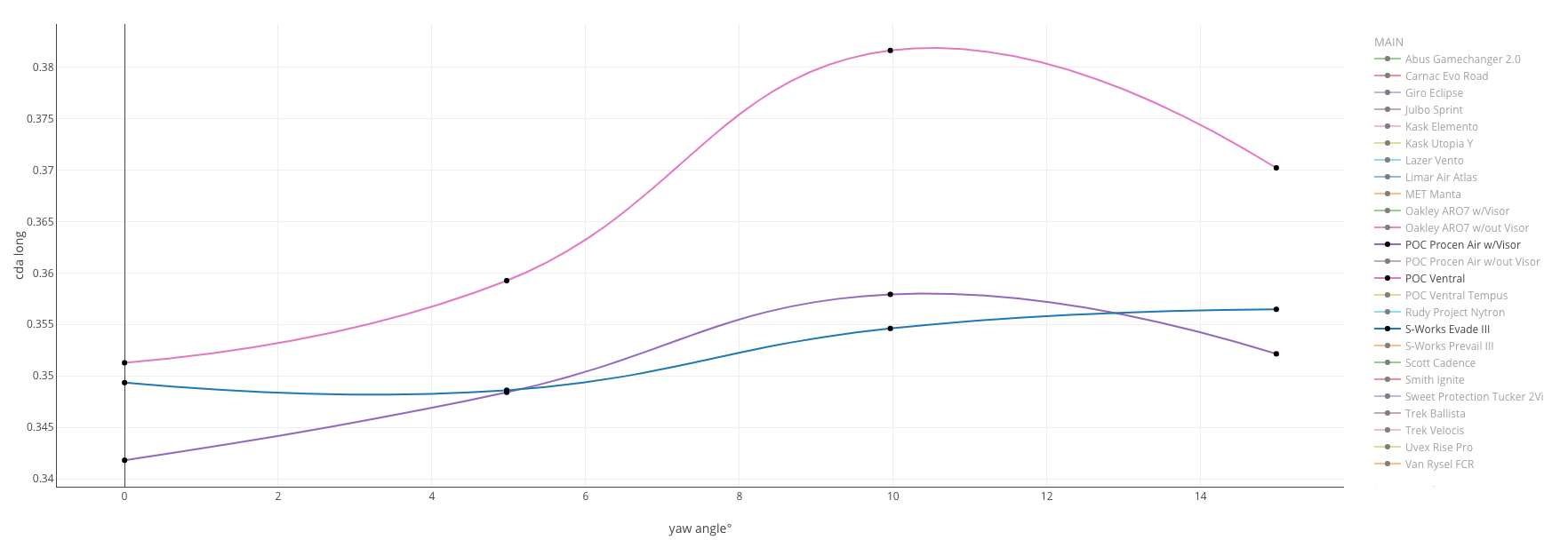
Second place goes to the Specialized S-Works Evade III, with an average CdA of 0.3523. This is a solid performance and, given the TT heritage and divisive aesthetic of the POC Procen Air, it's perhaps the helmet that many people will consider the one to buy.
Compared to the slowest on test, the Evade III will save you 47 seconds in a 40km TT (at 250 watts). However, when compared to the Procen, you'll be eight seconds slower, and have to put out an extra 1.8 watts to hold 40km/h. With that said, the data at 5 and 10 degrees of yaw actually put the Specialized on top, so the reality is likely less clear cut.
3. POC Procen Air w/out Visor
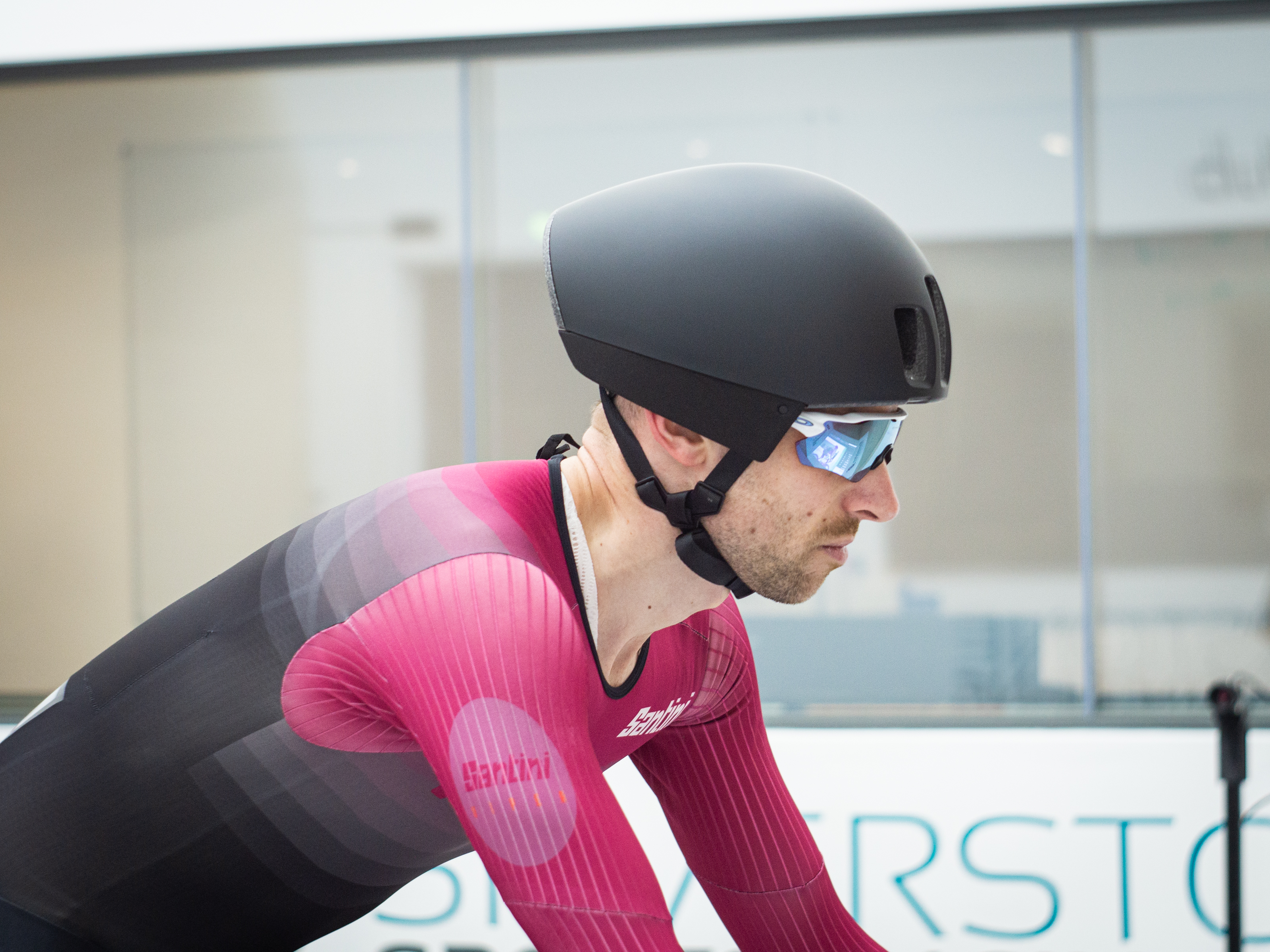
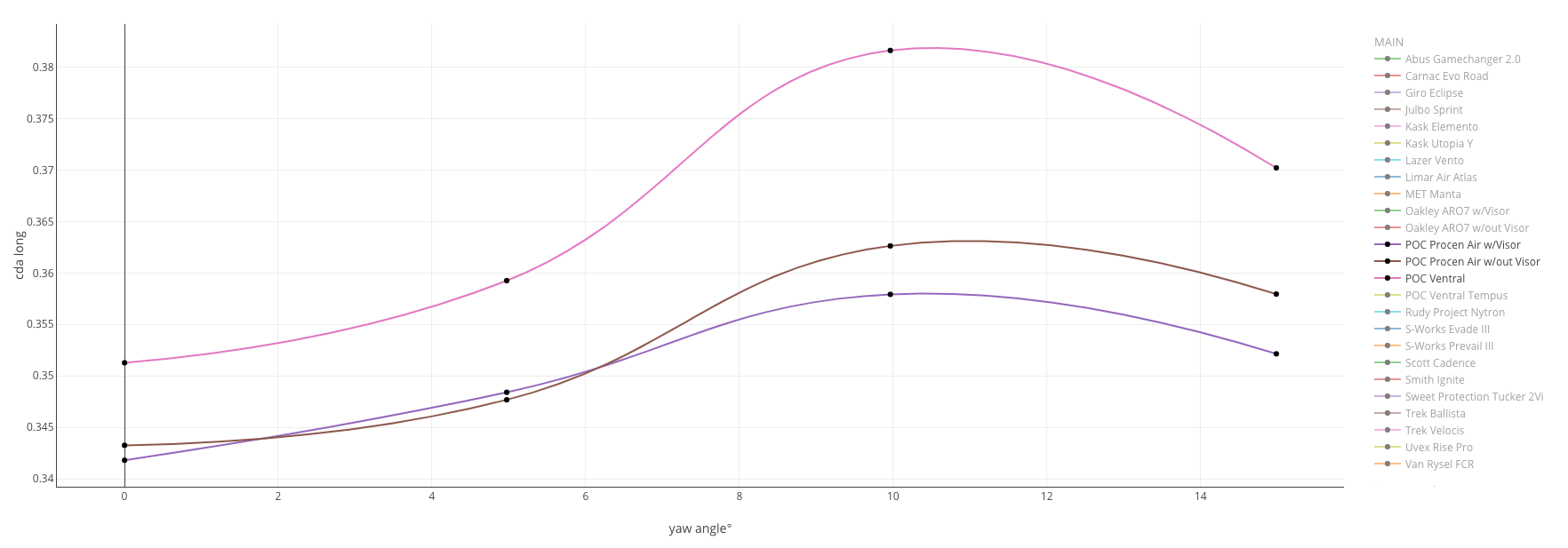
Interestingly, when you remove the POC Procen Air's visor, it's still among the quickest helmets in our test, but with an average CdA of 0.3529, you give away 10 seconds in that 40km TT, or you need to pedal 2.3 watts harder to achieve 40km/h.
Of course, wearing the visor might increase the temperature, and this data doesn't account for any changes to your comfort or core temperature, so there are caveats to the result.
4. Scott Cadence
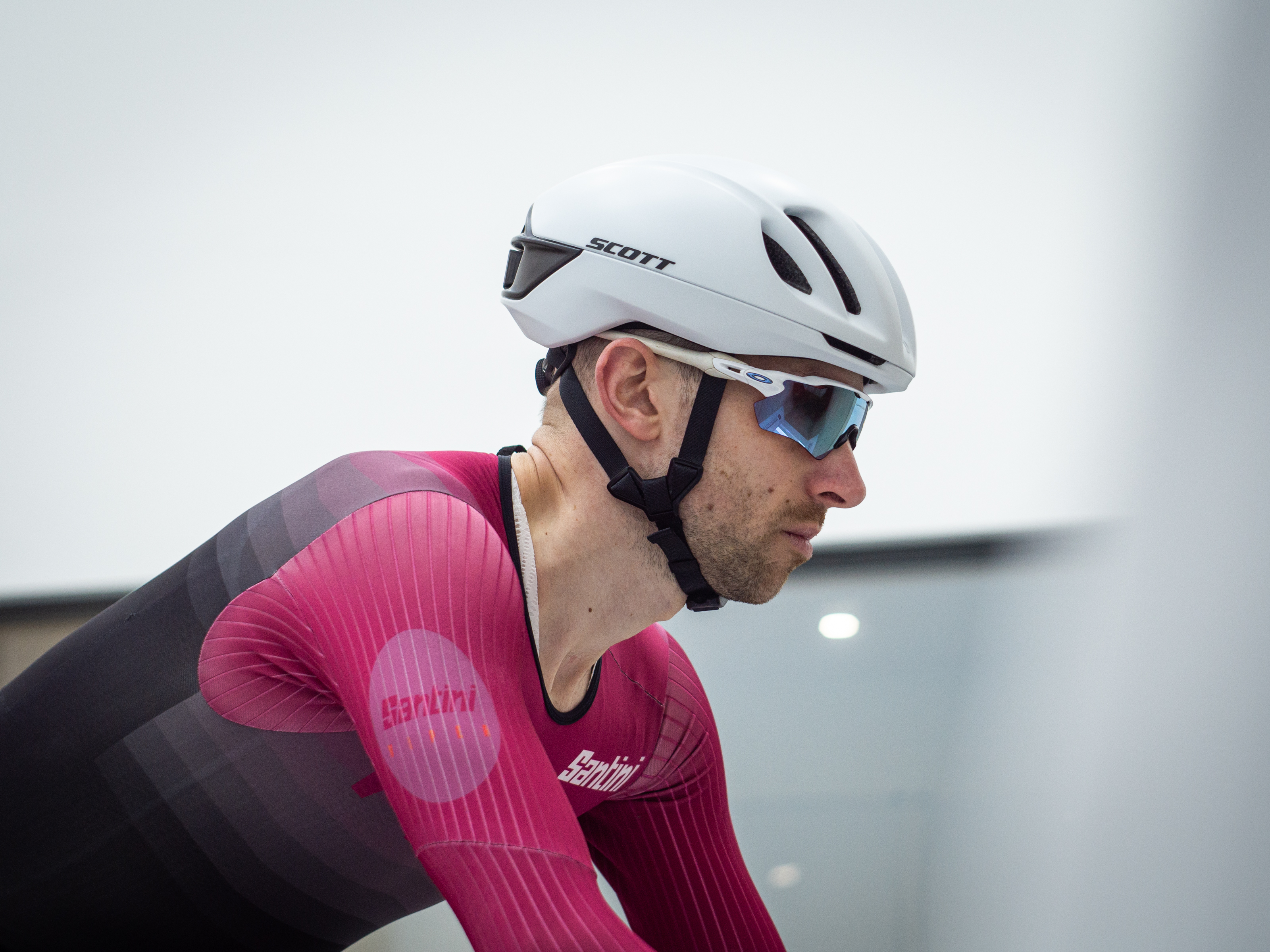
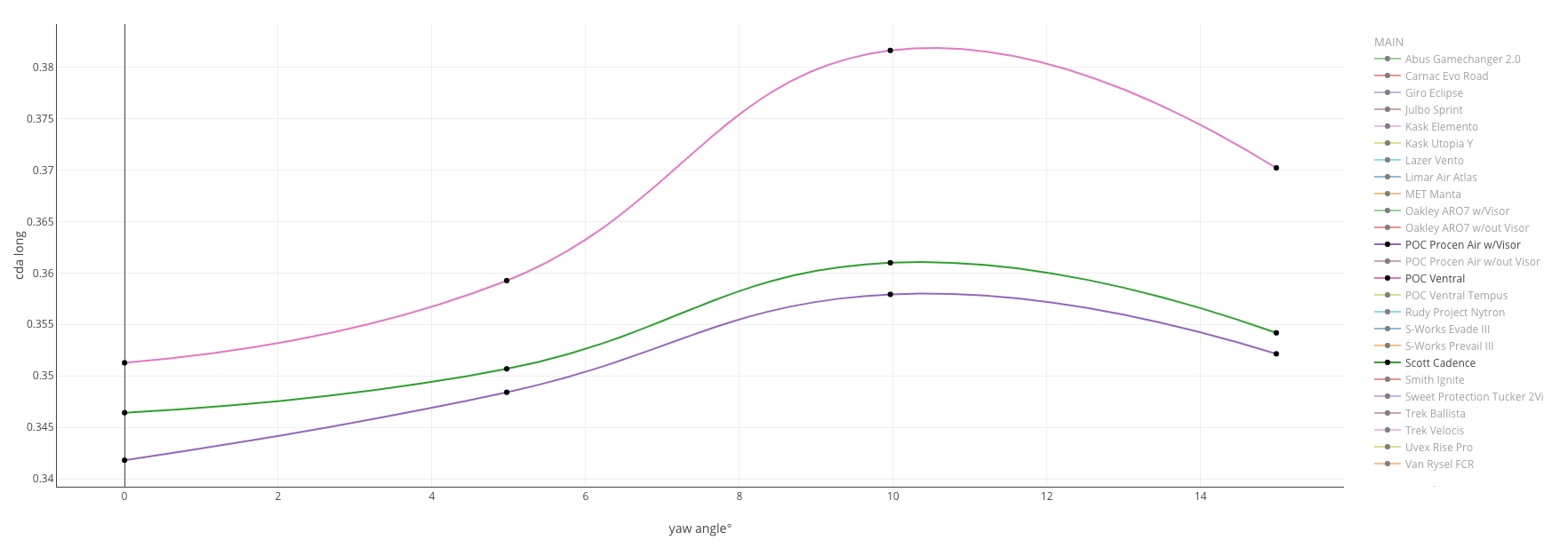
Next up, rolling into an impressive fourth place is the recently renewed Scott Cadence with an average CdA of 0.3531. This is the helmet that the Team DSM Firmenich Post NL team have been wearing this season, and was worn by Pfeiffer Georgi to her first ever Paris-Roubaix podium.
This will save you 10.29 watts at 40km/h when compared to the slowest on test, or if you were to hold 250 watts in our arbitrary 40km time trial, you'd arrive at the finish 44 seconds sooner. However, you'd finish three seconds slower than if you had worn the S-Works Evade above.
5. Van Rysel FCR
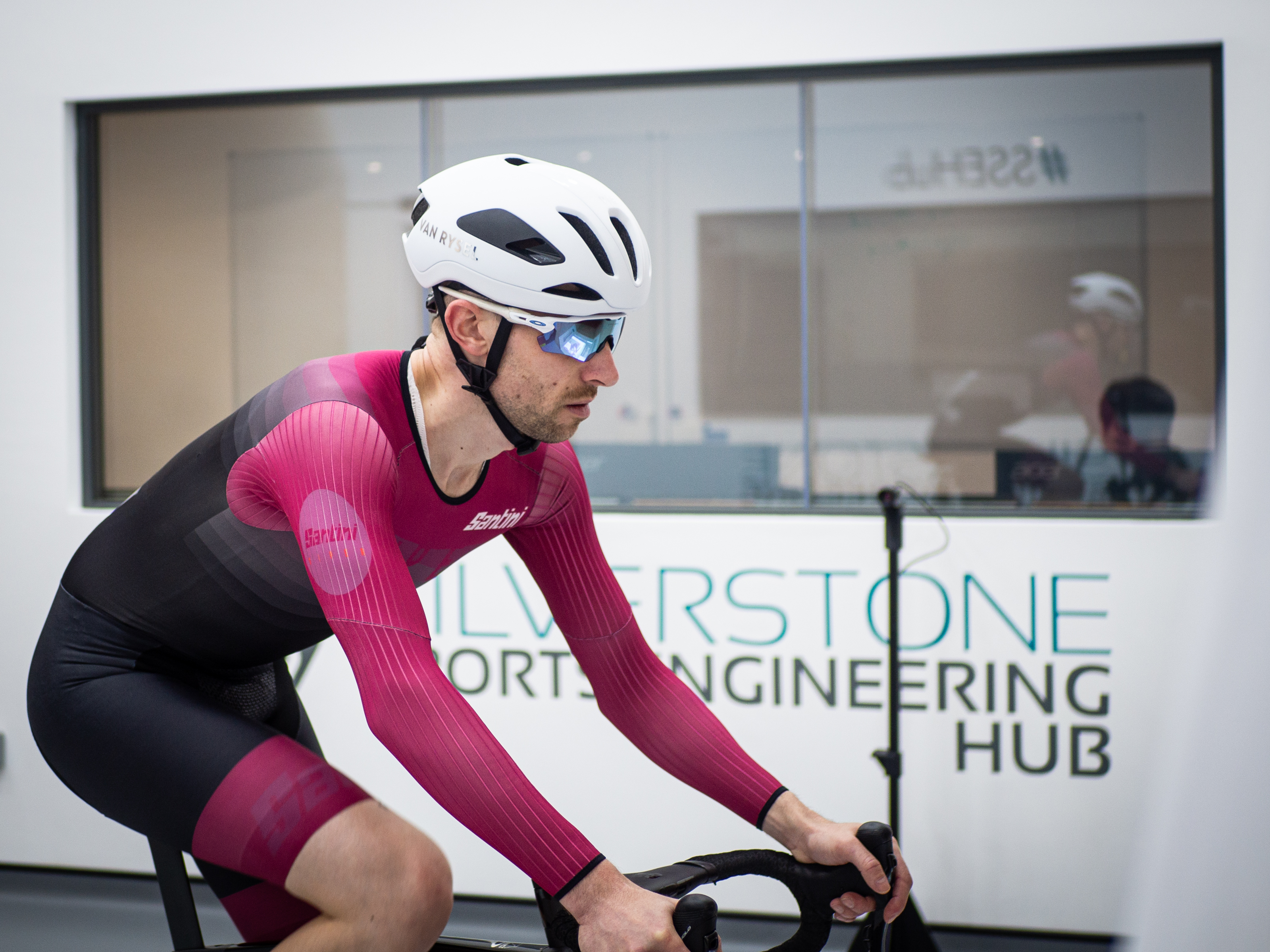
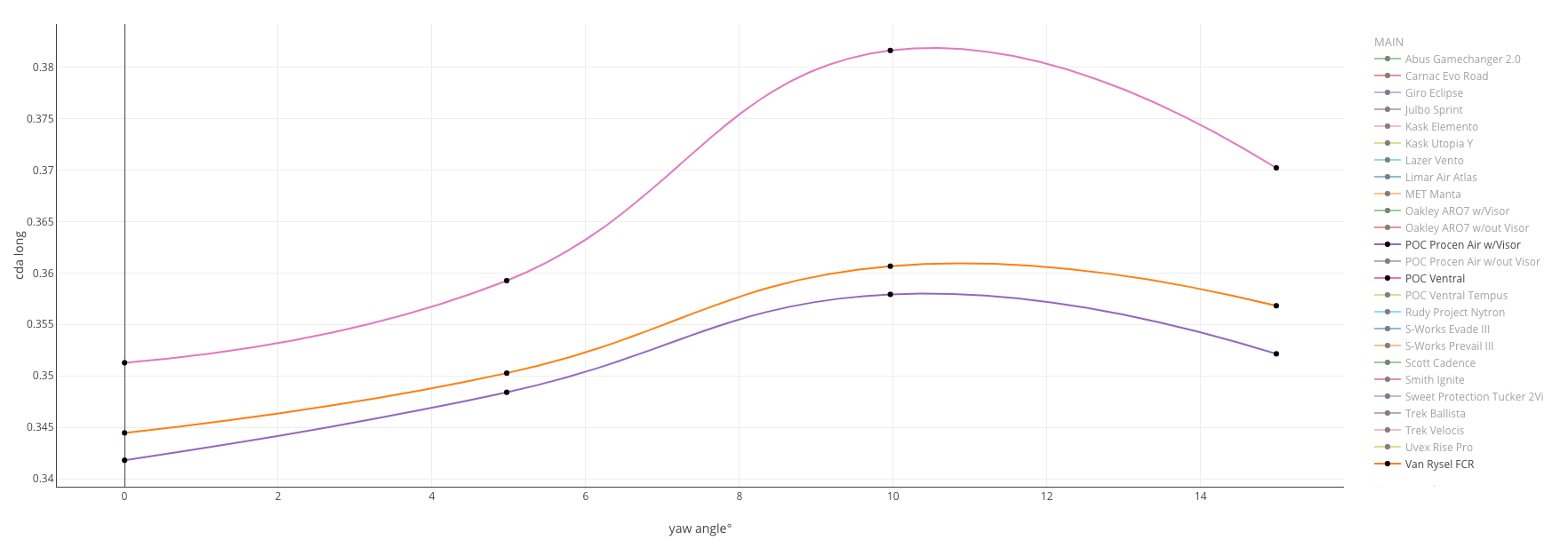
Sneaking into a very close and hugely impressive fifth place is the Van Rysel FCR, with an average CdA of 0.3531; exactly the same as the Scott Cadence.
We had to list them in order, though, so we went down to more decimal places to split these two, but what it means in the real world is that either helmet offers almost identical aero performance. Looking at the specific yaw angles, the Cadence is marginally faster at 0, 5 and 10, but when the crosswinds start to blow, it stalls and the FCR steps up.
However, one very big factor to bear in mind is the price. At just £89.99, this helmet undercuts most others on the test by a significant margin. The Cadence will set you back almost three times as much, while the winning helmet in this test is more than FOUR times more expensive at £360.00.
If you're looking for aero performance at a price, this has to be on your list.
6. Giro Eclipse
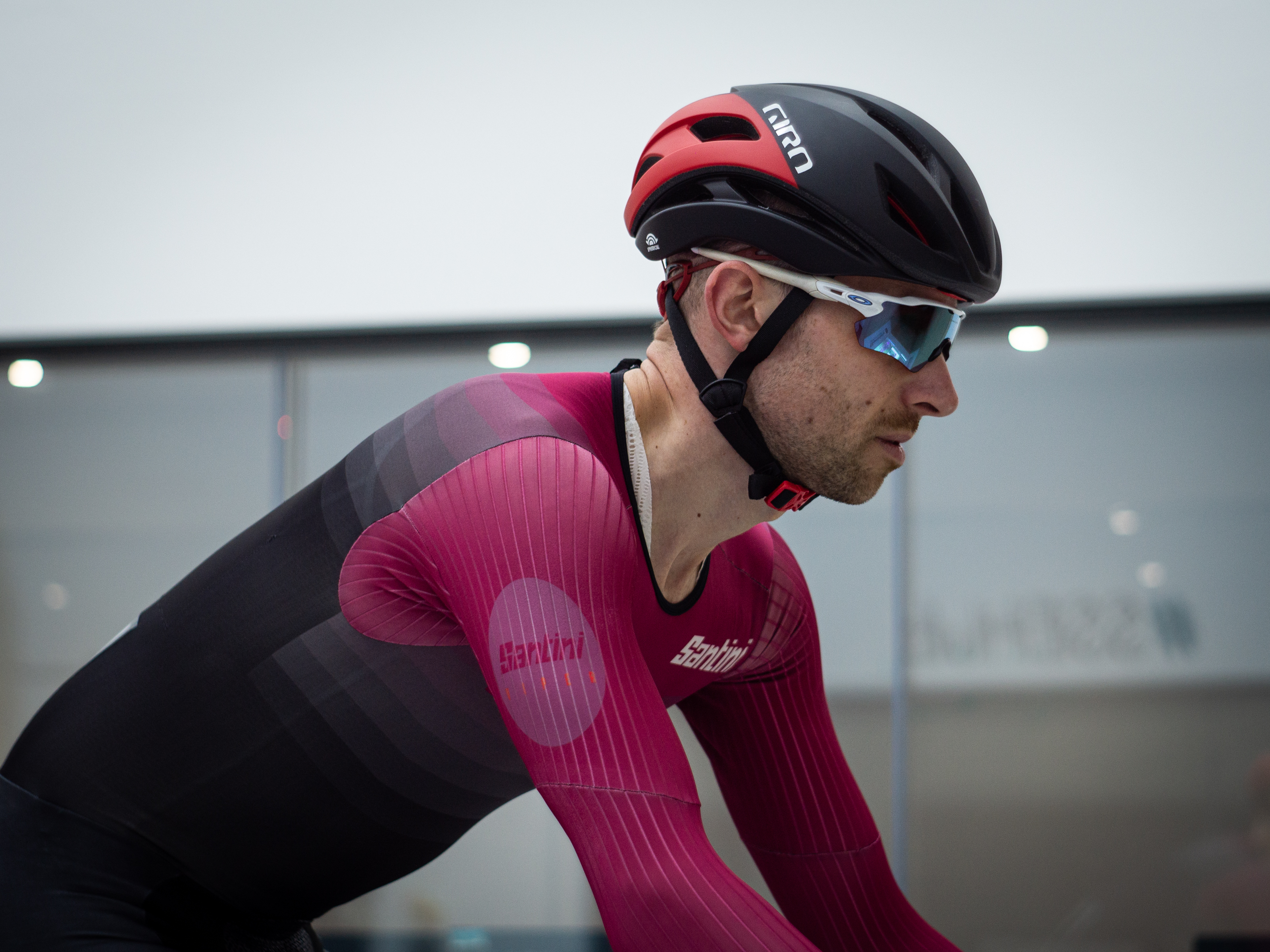
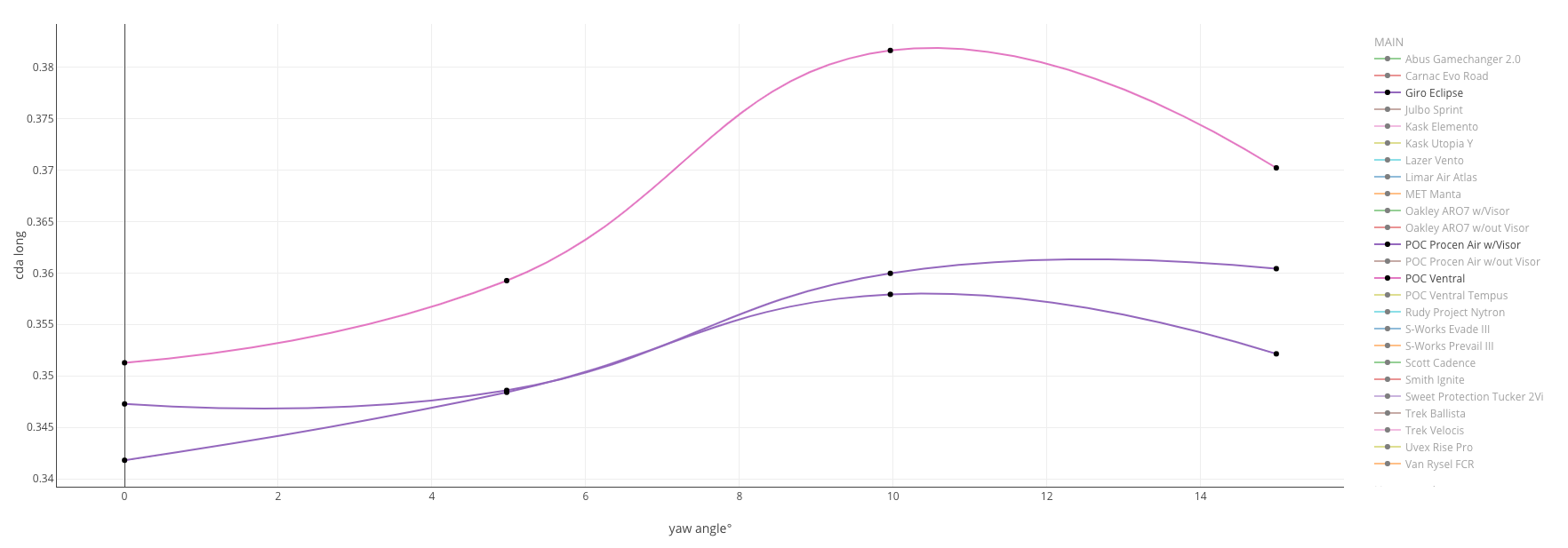
Next up, rolling into 6th place is another surprise performer. The Giro Eclipse, which currently sits at the very top of Virginia Tech's independent impact test table, looks more like a vented helmet than a dedicated aero helmet, but in our testing, it performed well with an average CdA of 0.3541.
This would save you 40 seconds versus the slowest on test in a 40km time trial, but would lose you 14 seconds when compared to the winner.
As we've found in our best road bike helmets buying guide, a lot of people find themselves torn between this and the S-Works Prevail III, as they both performed well in the Virginia Tech test. In my own experience, the ventilation of the Specialized is leagues ahead, but aerodynamically the Giro would save you a not-insignificant 3.87 watts at 40km/h.
7. Trek Ballista
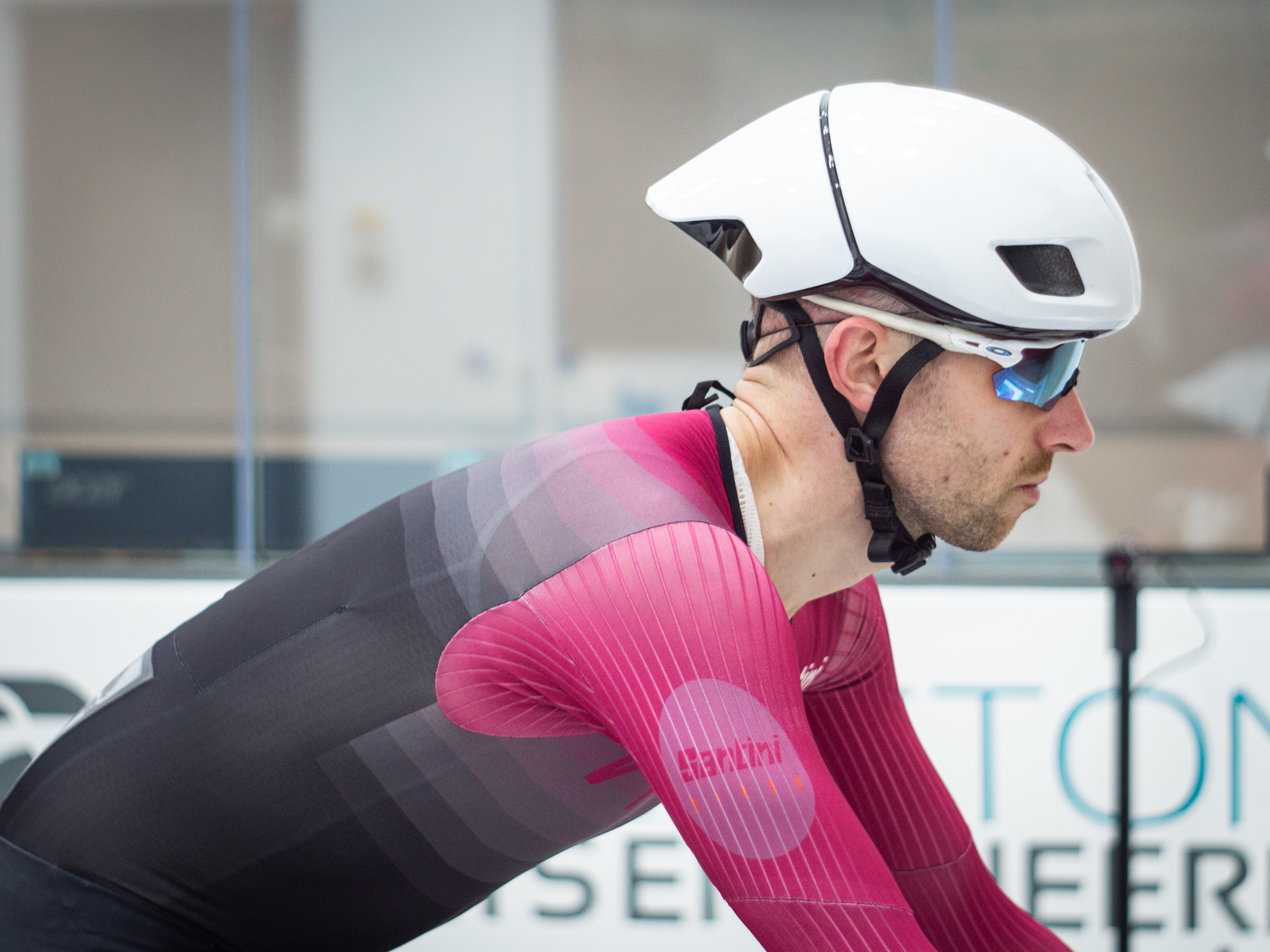
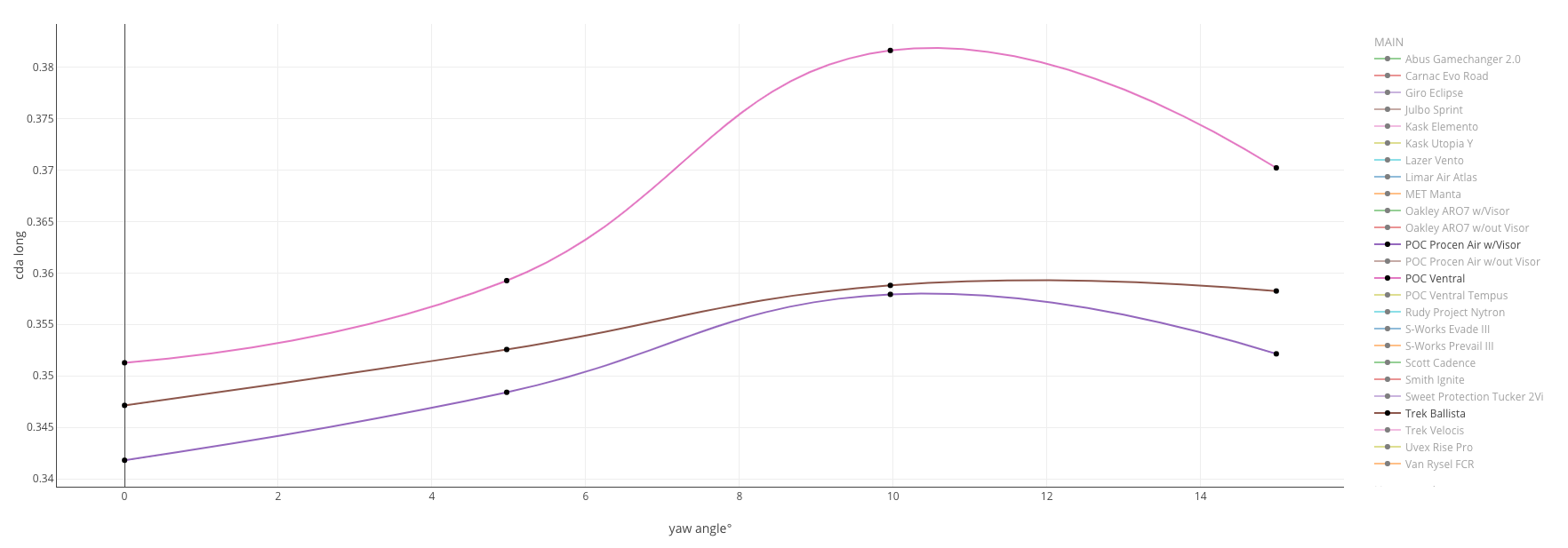
In 7th place is the latest version of the Trek Ballista, an aero helmet that undoubtedly shouts 'aero' in the way that it looks. The performance doesn't quite match its unashamed aesthetic against a few of the others here, but with an average CdA of 0.3542, it will save you 9.38 watts compared to the slowest on test at 40km/h, and 40 seconds in a 40km TT.
8. Trek Velocis
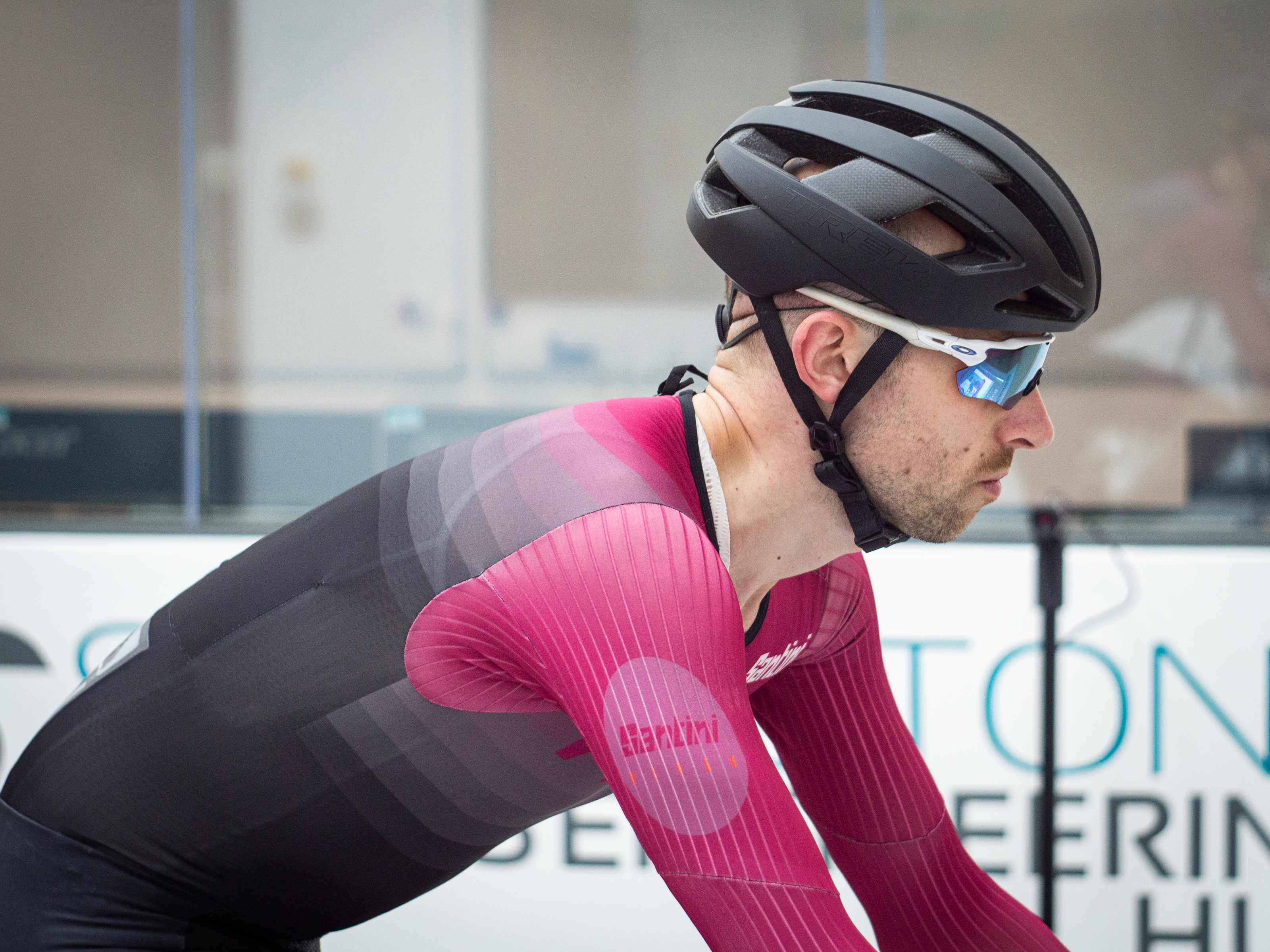
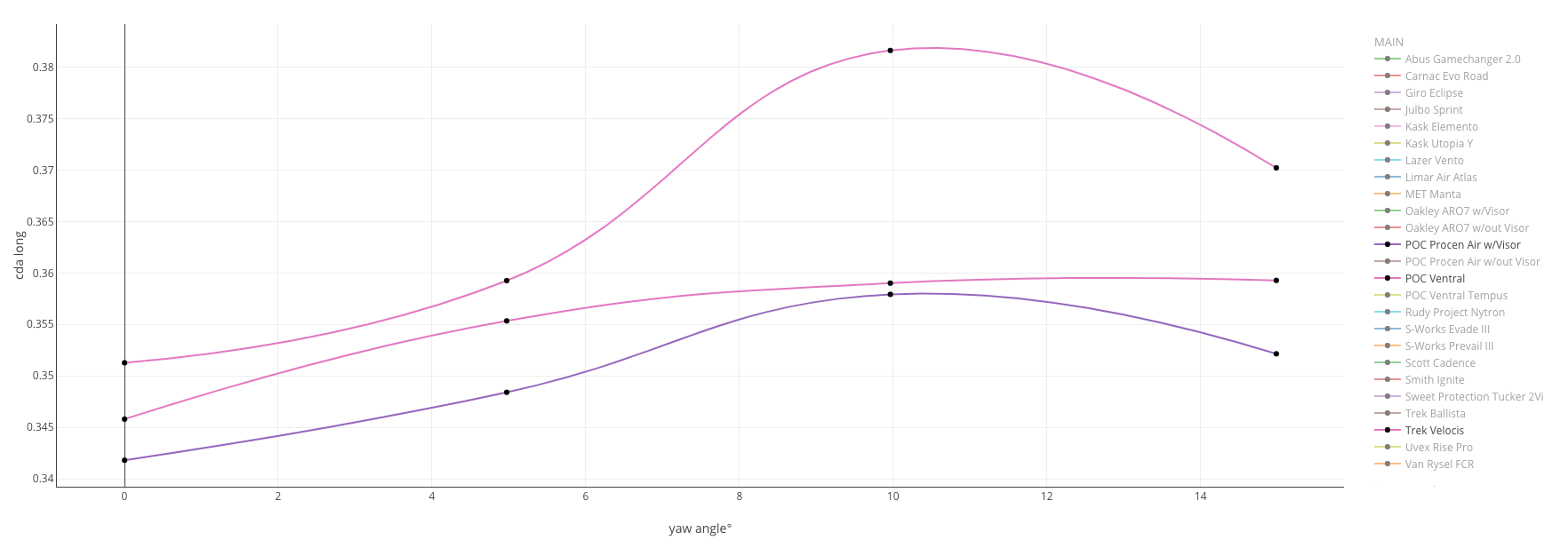
Perhaps more of a surprising result in the Trek camp is the Velocis, with an average CdA of 0.3549. This means it will finish just three seconds slower than the Ballista, or you'd need to generate a little over half a watt more to sustain 40km/h.
Given its unashamed aero shape with long tail, we'd hazard a guess that the Ballista would test faster in a more aggressive aero position, so it might still be the helmet of choice for solo breakaway artists, but for those of you riding in multiple positions in varying conditions, this is a great choice.
9. Julbo Sprint
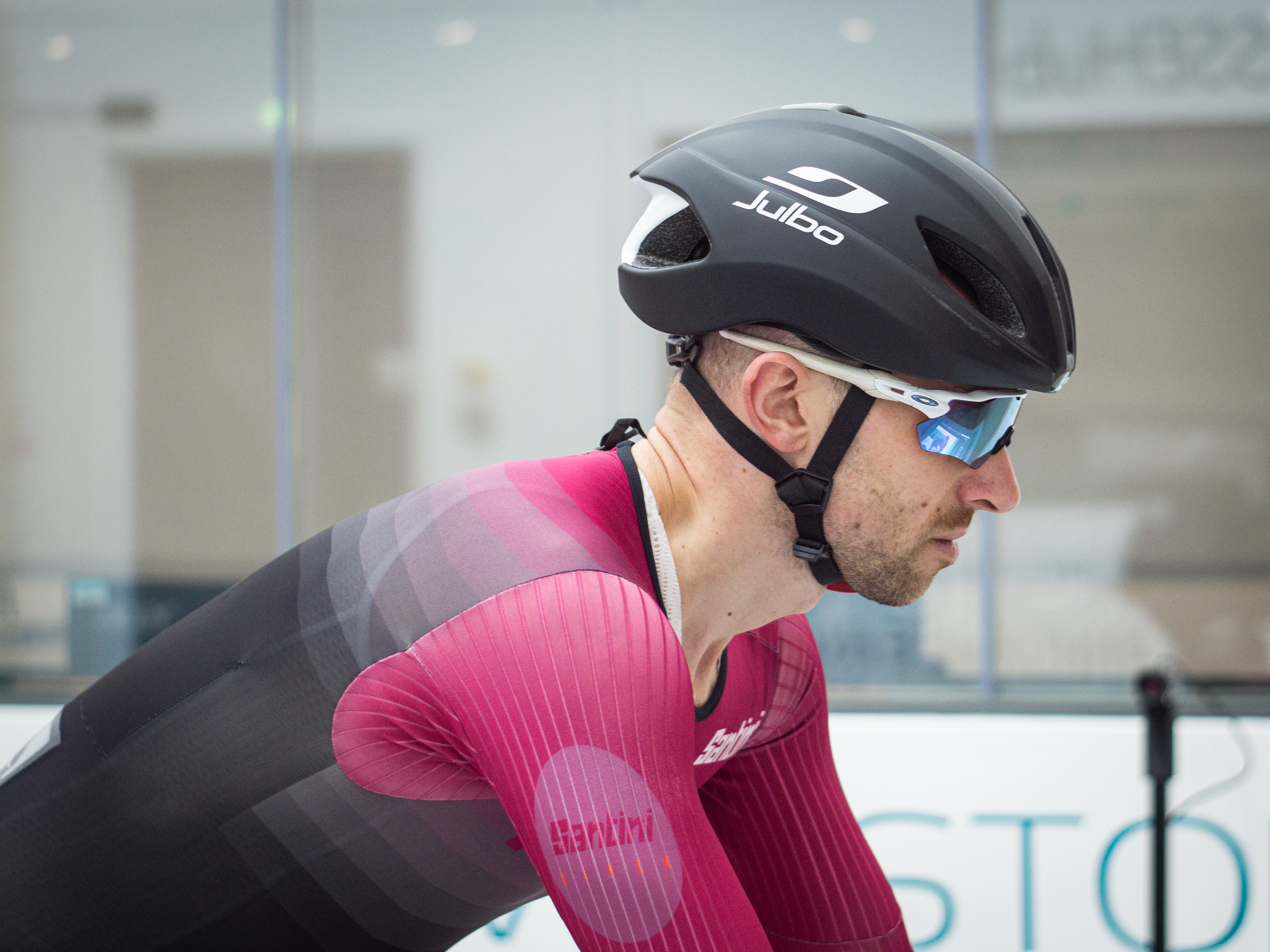
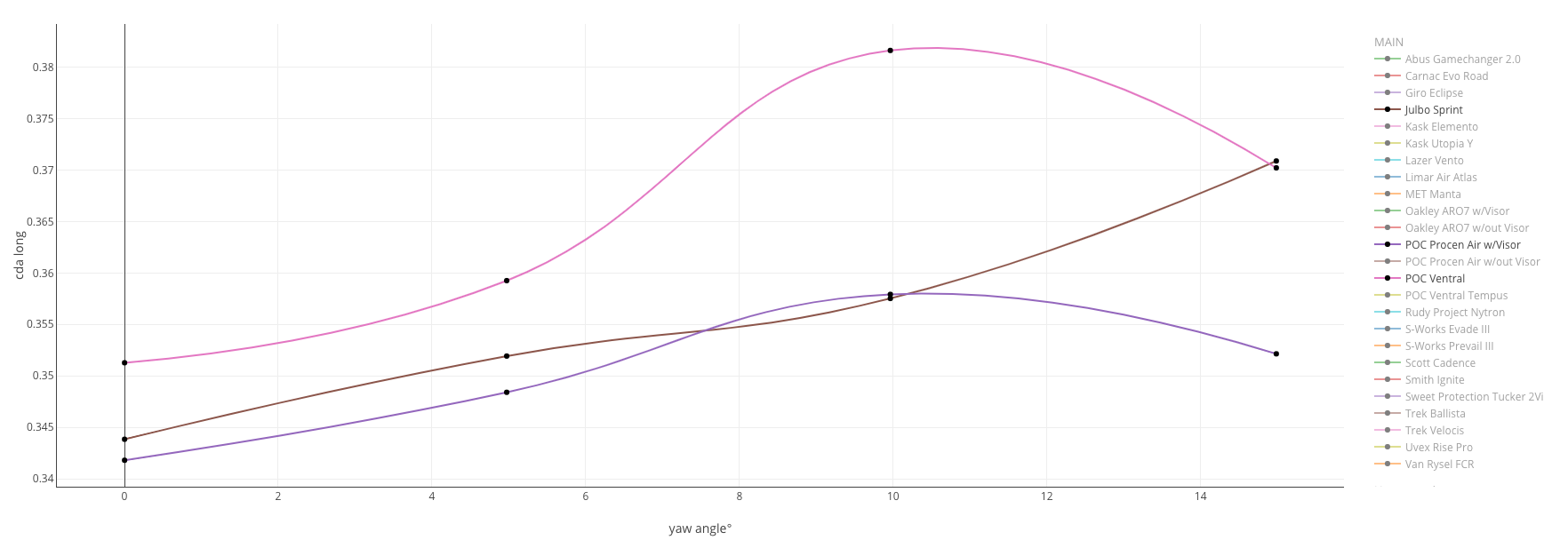
In 9th place, rolling comfortably at the front end of a mid-table finish, is the French brand Julbo with its Sprint helmet, with an average CdA of 0.3560. This helmet is being used by the Groupama FDJ men's team this season, and compared to some of the other models shown here, is a reasonably priced affair at €149.90.
Interestingly, Groupama were wearing Giro Eclipse helmets before partnering with Julbo, and based on our testing, that move cost them around three watts (at the faster peloton speeds of 50km/h), although we understand that different riders in different positions may see different results.
10. Kask Utopia Y
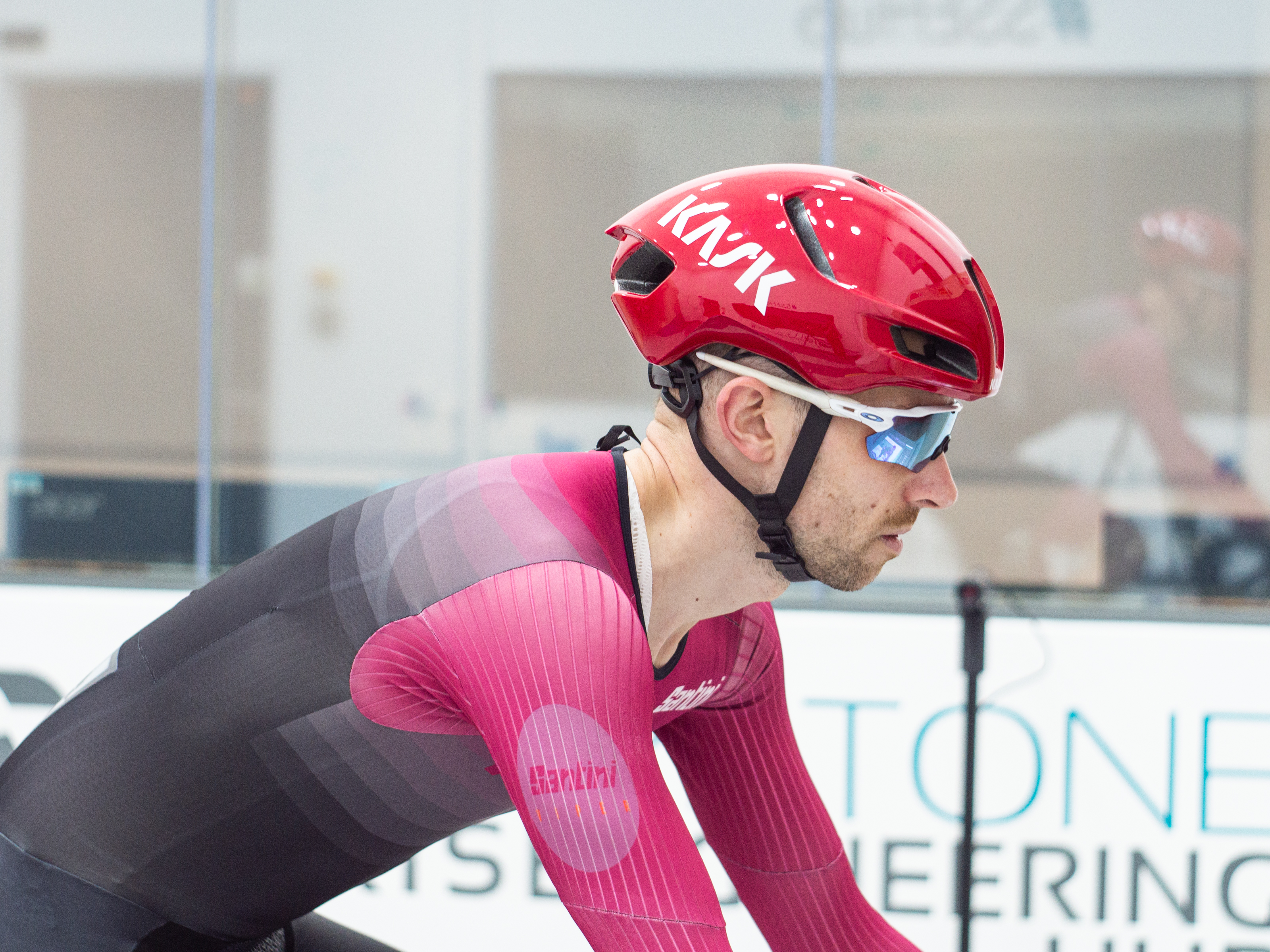
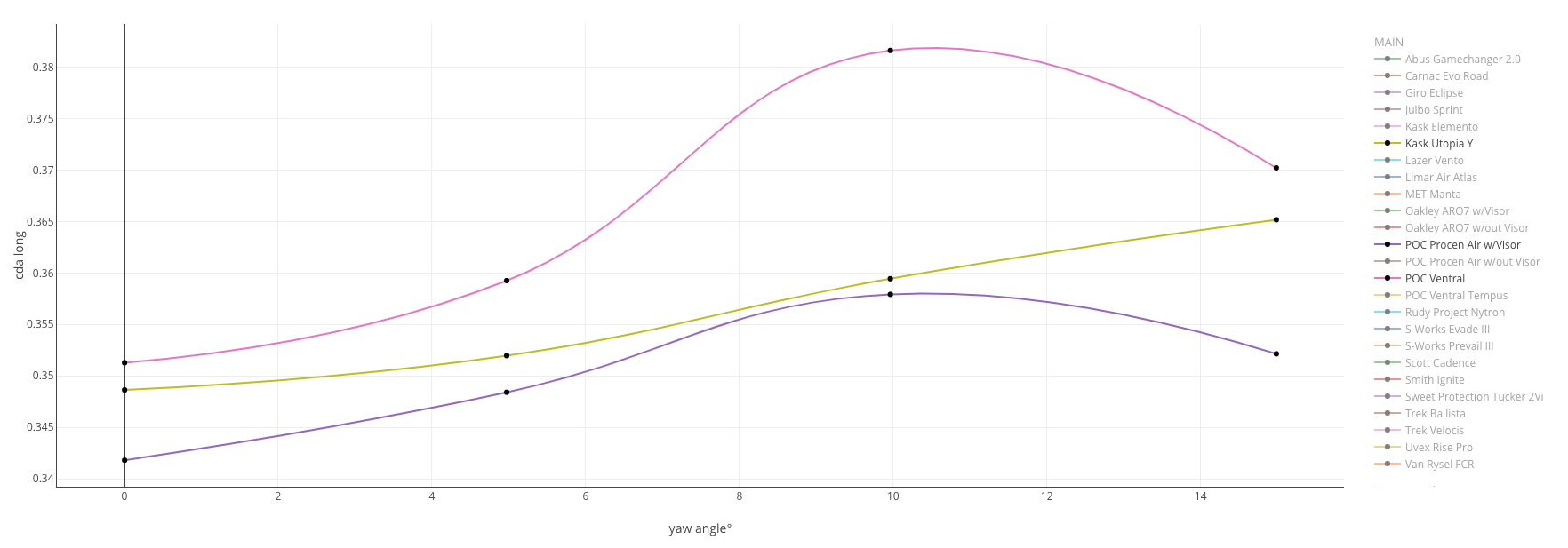
In 10th place is the first of two helmets from Italian brand Kask, with the Utopia Y aero helmet.
The Utopia Y is the minimally updated version of the original Utopia helmet, which has been around for more than five years, so given the age of the design it's maybe not a massive surprise to see it struggle to challenge the newer products.
Compared to the winning POC Procen Air, you'd need to generate an additional 5.1 watts to sustain 40km/h. Bump that up to 50km/h and that difference grows to nearly 10 watts. Compared to the more road-style S-Works Evade III, you'd finish a 40km time trial 15 seconds off the pace.
With all that said, Kask has a new aero helmet on the way. Rumours tell us that it's called the Nirvana, but you probably know it as 'the one that comes down over the ears'. It's been in use by Ineos Grenadiers so far this season, and despite our best attempts to get hold of a sample for this test, neither Kask or Ineos were able to help.
11. Lazer Vento Kineticore
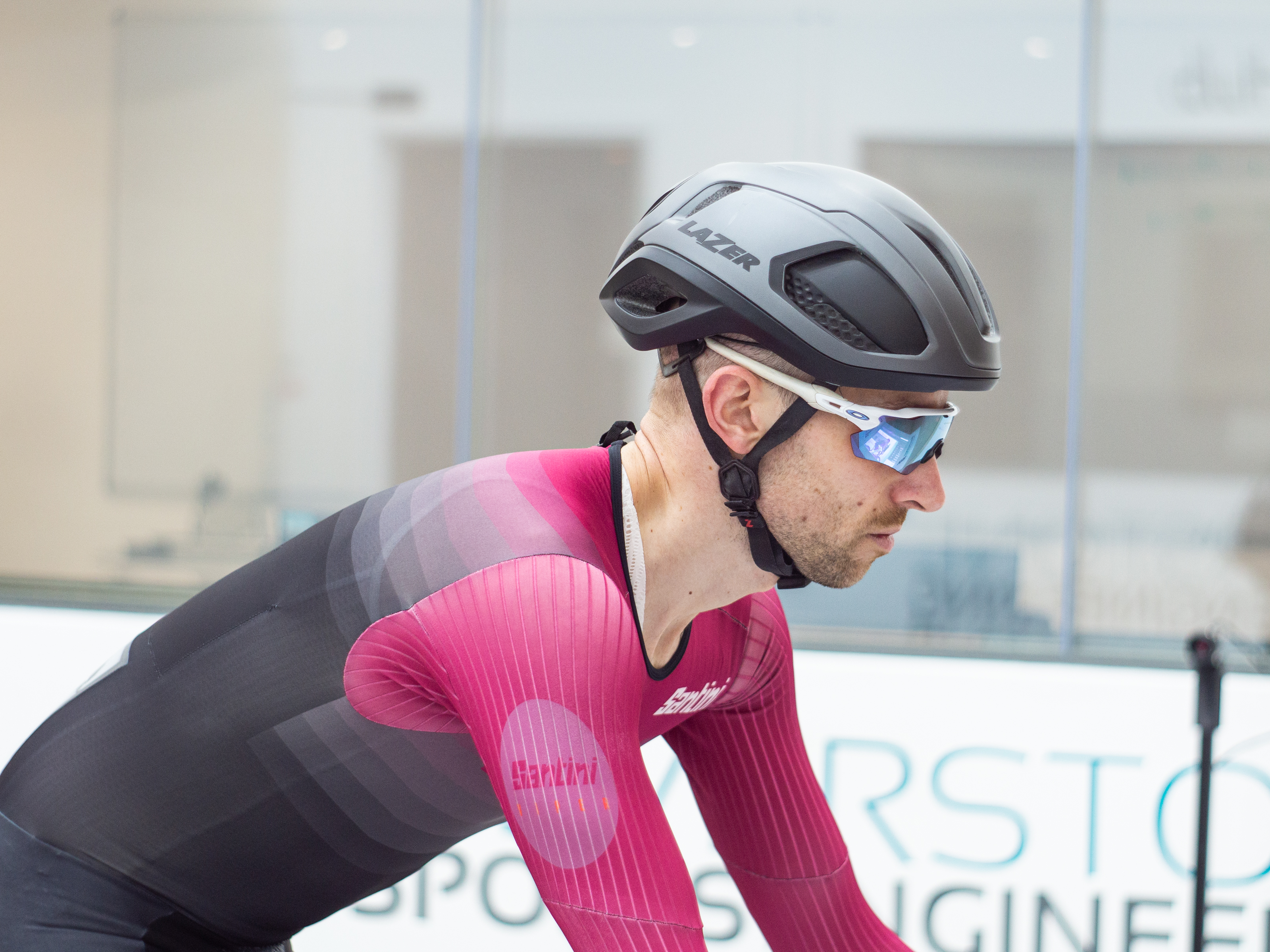
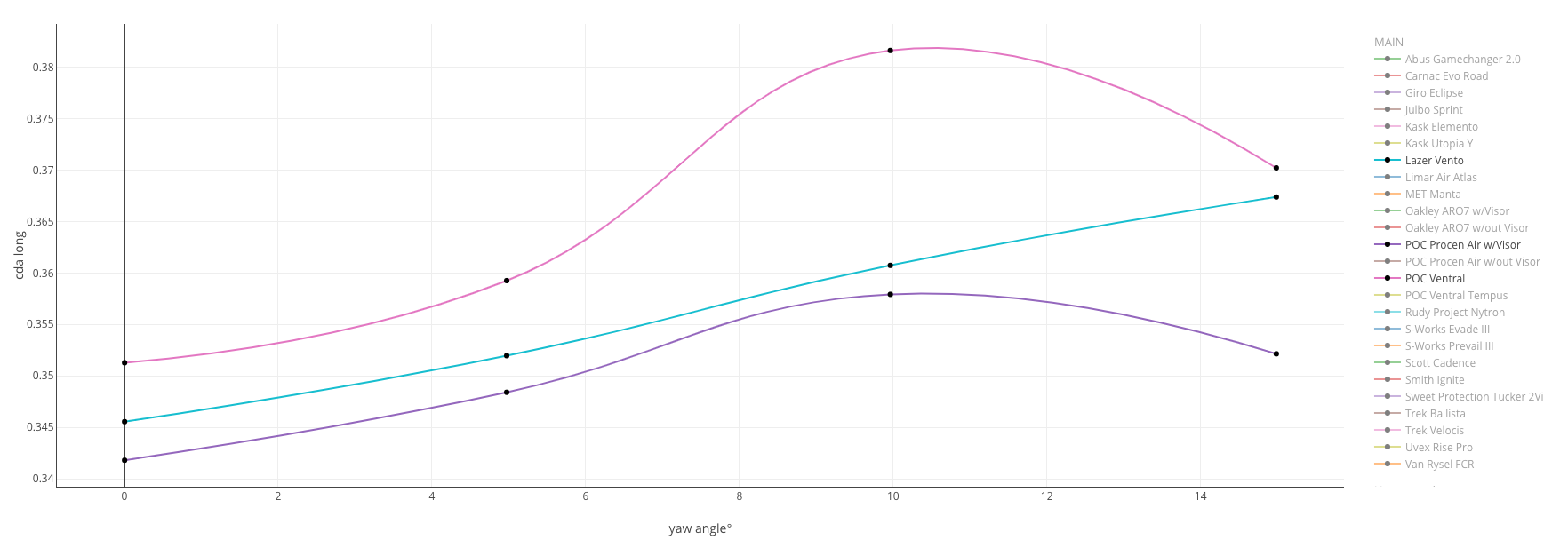
Just missing out on a top-10 performance is the Shimano offshoot, Lazer, with its Vento Kineticore helmet. The Kineticore brings some novel ideas to the helmet design table, not least the Kineticore technology itself, which moulds the internal EPS foam into blocks that can shear and break in the event of a crash, offering superior rotational impact protection when compared to a standard EPS construction, as well as additional airflow inside.
It also replaces the dial retention tightening system with a 'Scrollsys' rolling belt that's integrated cleanly into the back of the helmet, as well as a twist-in rear light that adds versatility for those riding beyond daylight hours.
It might not be the fastest helmet on this test, but it's far from the slowest and there are a handful of other reasons to buy it.
12. MET Manta
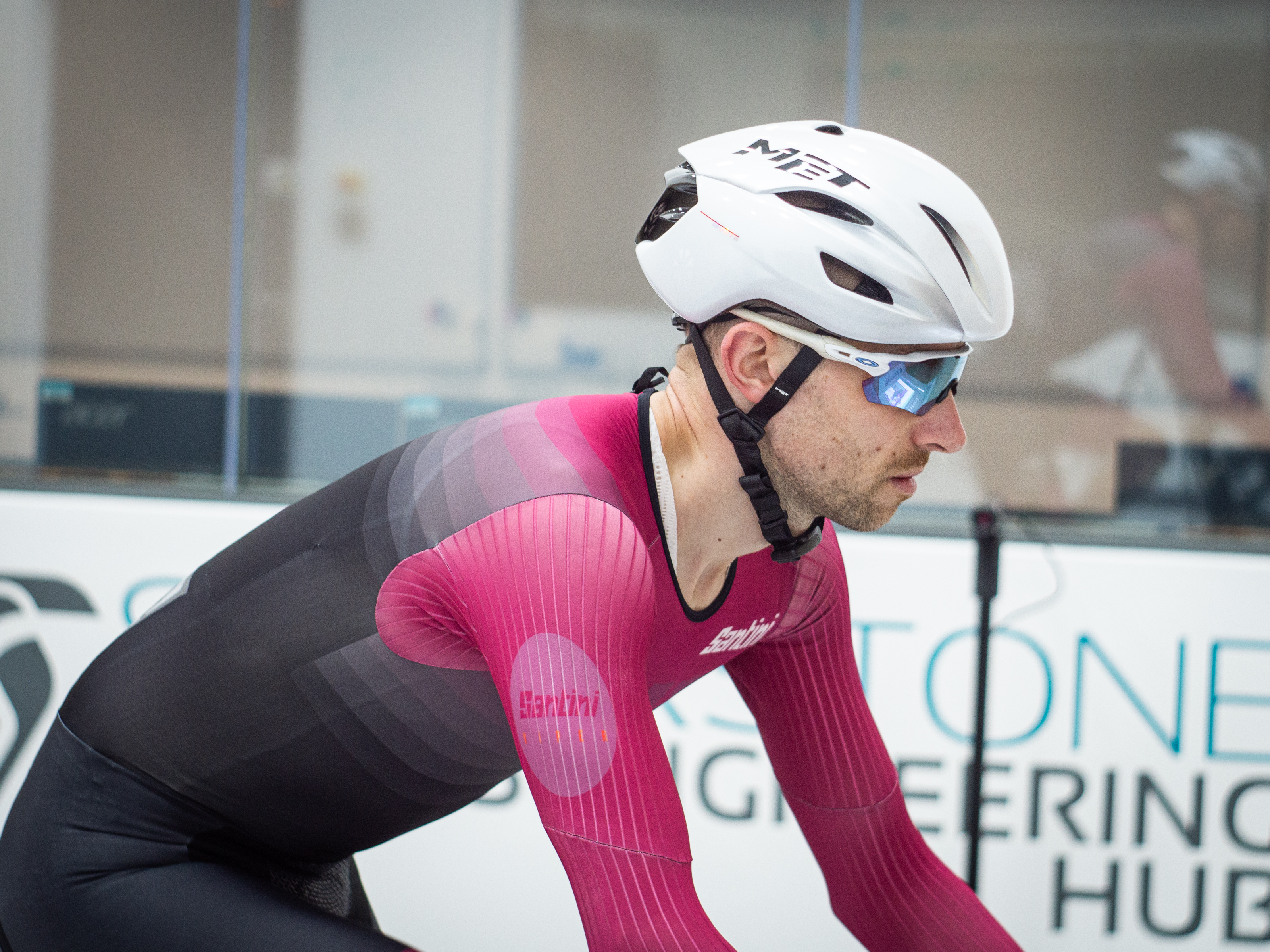
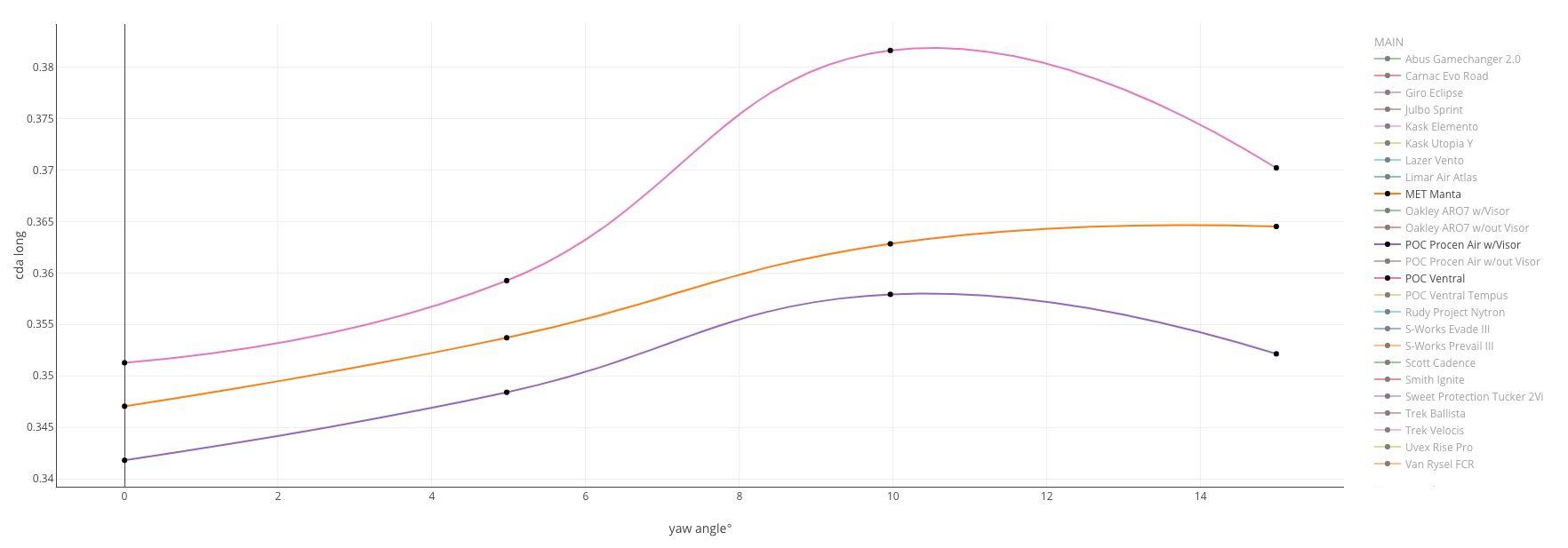
Given MET sponsor the UAE Team Emirates squad, the MET Manta is commonly seen atop the head of Slovenian superstar, Tadej Pogačar. It comes with a MIPS liner, albeit the less inconspicuous variant that puts a physical liner between the head and the EPS foam.
The result here is somewhat surprising, given Met has access to its own wind tunnel, but we'll take a second here to remind everyone that the results may vary slightly from rider to rider.
With that said, our test puts the Manta into 12th place, which is a solid mid-table result and one that beats out helmets much pricier and much more geared towards the aero design.
13. Smith Ignite
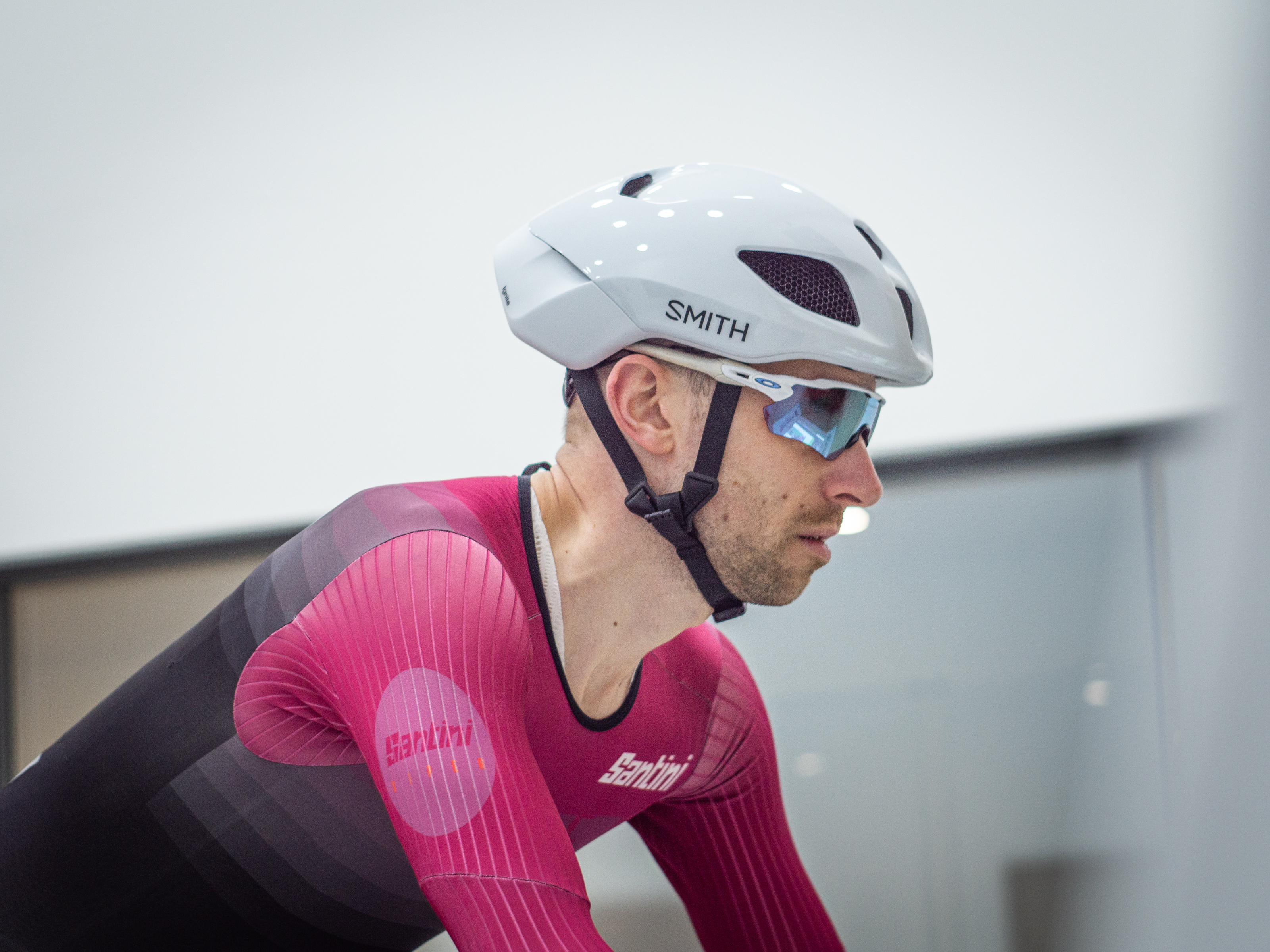
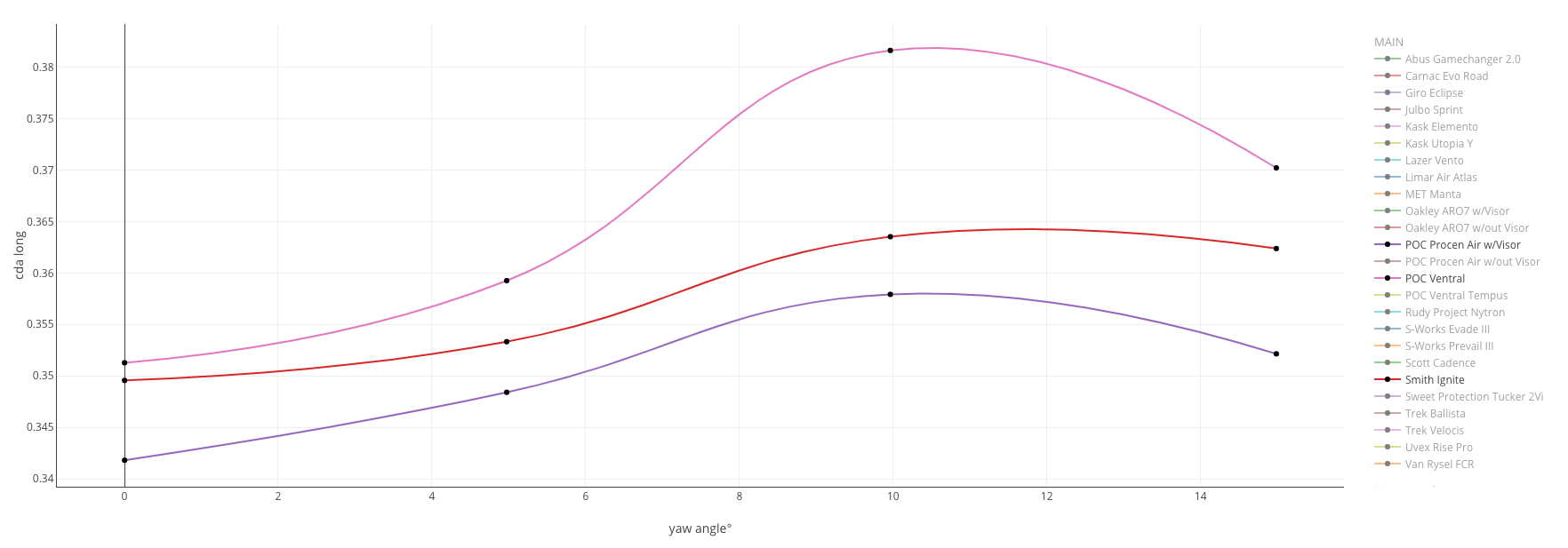
In 13th place, the Smith Ignite stands out for one main reason: Koroyd. While some helmets employ MIPS for rotational impact protection, and others create their own designs, such as Lazer's Kineticore, Smith looks to Koroyd.
This is a material that resembles a collection of straws bunched together, and it is said to allow shearing and compression at various angles, to increase safety. In our experience, it does come with downsides though, including a reduced airflow and an inability to scratch your head.
Regardless, the Ignite has landed a mid-table result here, which is pretty decent given it's been on the market for around half a decade already.
14. Sweet Protection Tucker 2VI
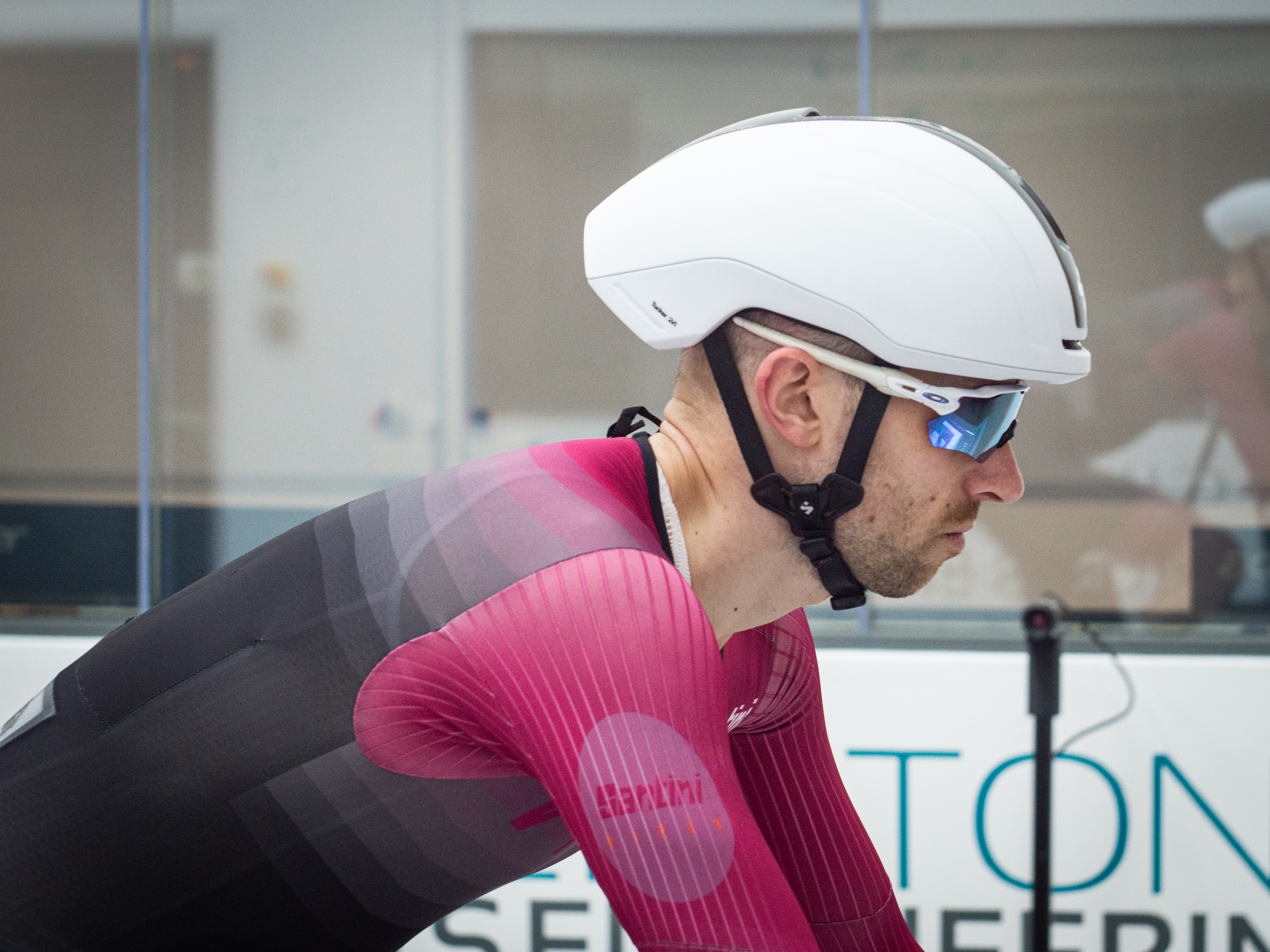
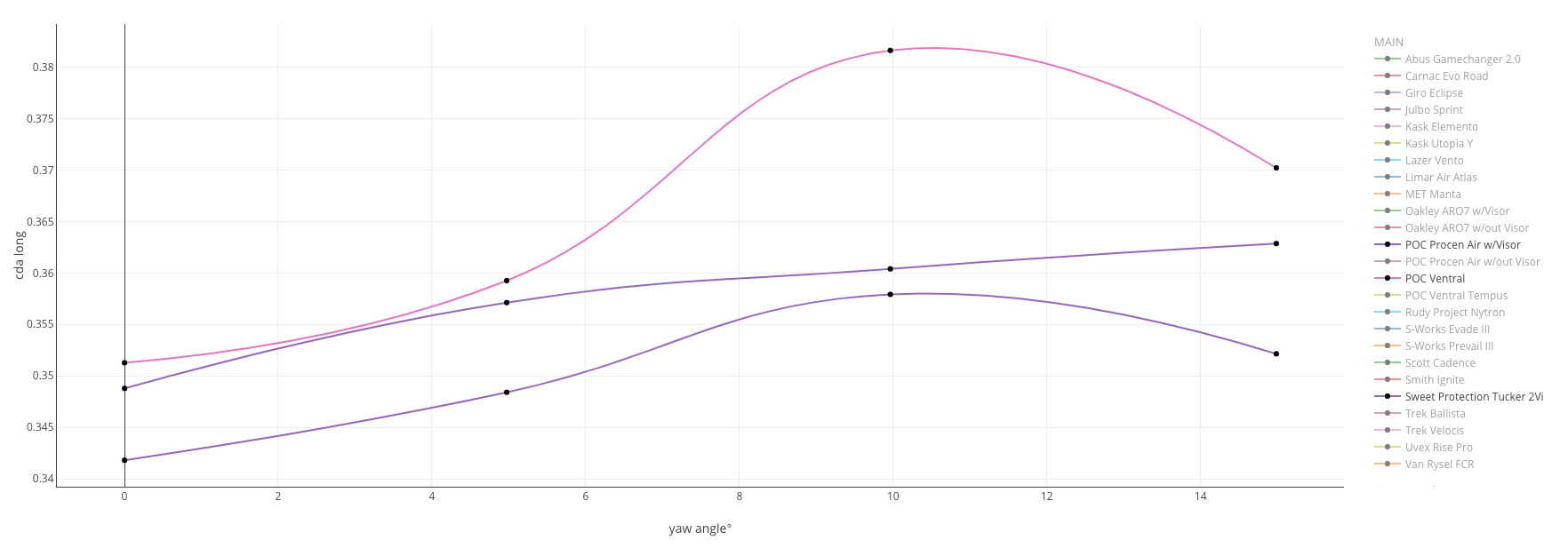
We're into the bottom half of the table now, but the Sweet Protection Tucker 2VI is still faster than 11 other helmets on this test, which is no mean feat. The Tucker is a reasonably enclosed helmet with two small vents at the front. One dries out the brow, while the other reduces pressure at the centre-most point. There's also a slot at the top to take advantage of the Venturi effect. It's borne out of the Tucker time trial helmet, but with the visor removed and a slight redesign.
It boasts MIPS's nicely inconspicuous Air Node system for added impact protection but the minuscule dial at the rear lets it down, as can be a bit tough to grasp, especially when wearing gloves.
Compared to the fastest on test, you'll be giving away just shy of six watts at 40km/h, or tackle a 40km at 250 watts and you'll lose around 25 seconds. That's a not insignificant amount of time, but still, a greater gap separates the Tucker 2VI and the slowest on test.
15. Kask Elemento
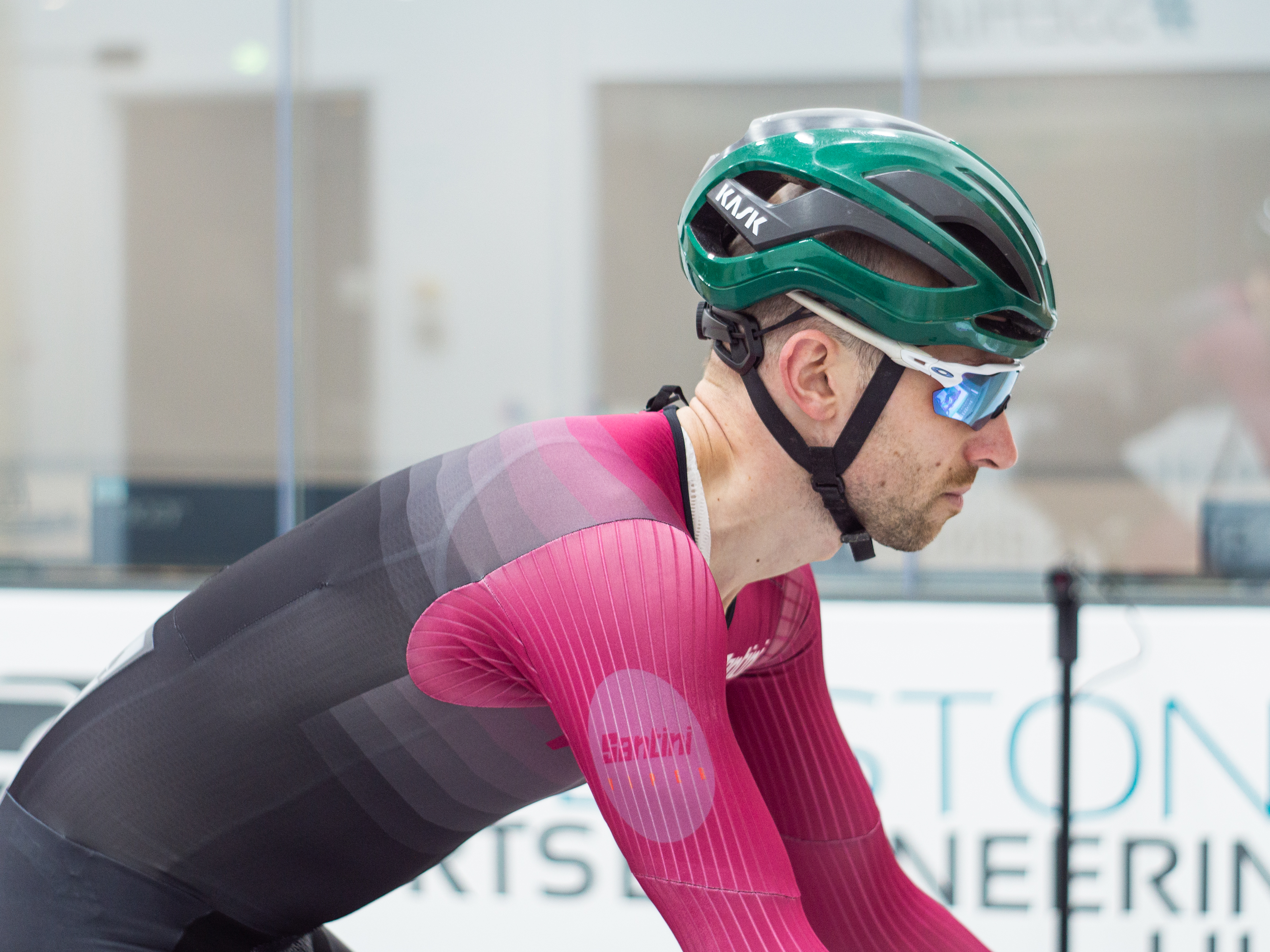
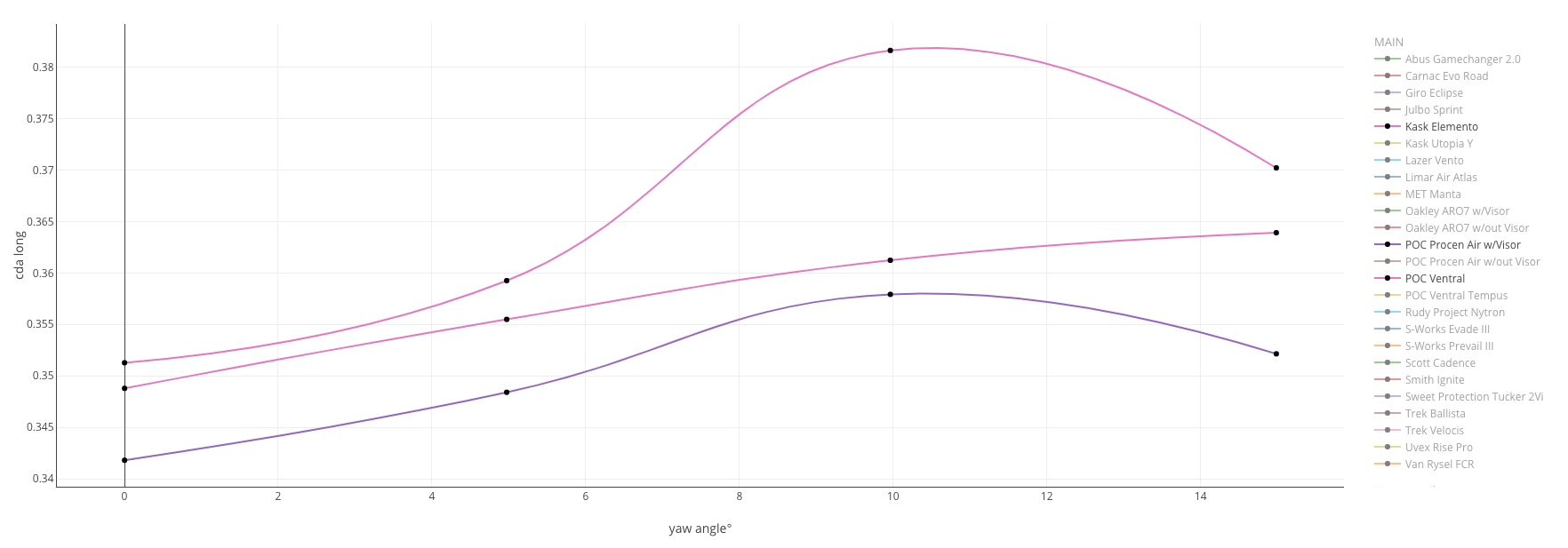
The helmet of choice for many of the Ineos Grenadiers team, the Kask Elemento is the next era of helmet design, according to the brand. A carbon fibre shell replaces traditional EPS foam, which means it can offer similar levels of impact protection with significantly less bulk. Elsewhere, 3D-printed pads replace traditional foam pads, and with their lattice-like construction, the airflow inside is improved.
The Elemento is a very expensive helmet, and there are a few good reasons to buy it, but all-out aero speed isn't its forte. A Kask spokesperson told Cyclingnews that this isn't a dedicated aero helmet, as its rounded shape suggests, and that it would land somewhere between the aero Utopia Y and the airy Valegro. We didn't test the Valegro, but the mid-table performance here suggests Kask was right.
16. Limar Air Atlas
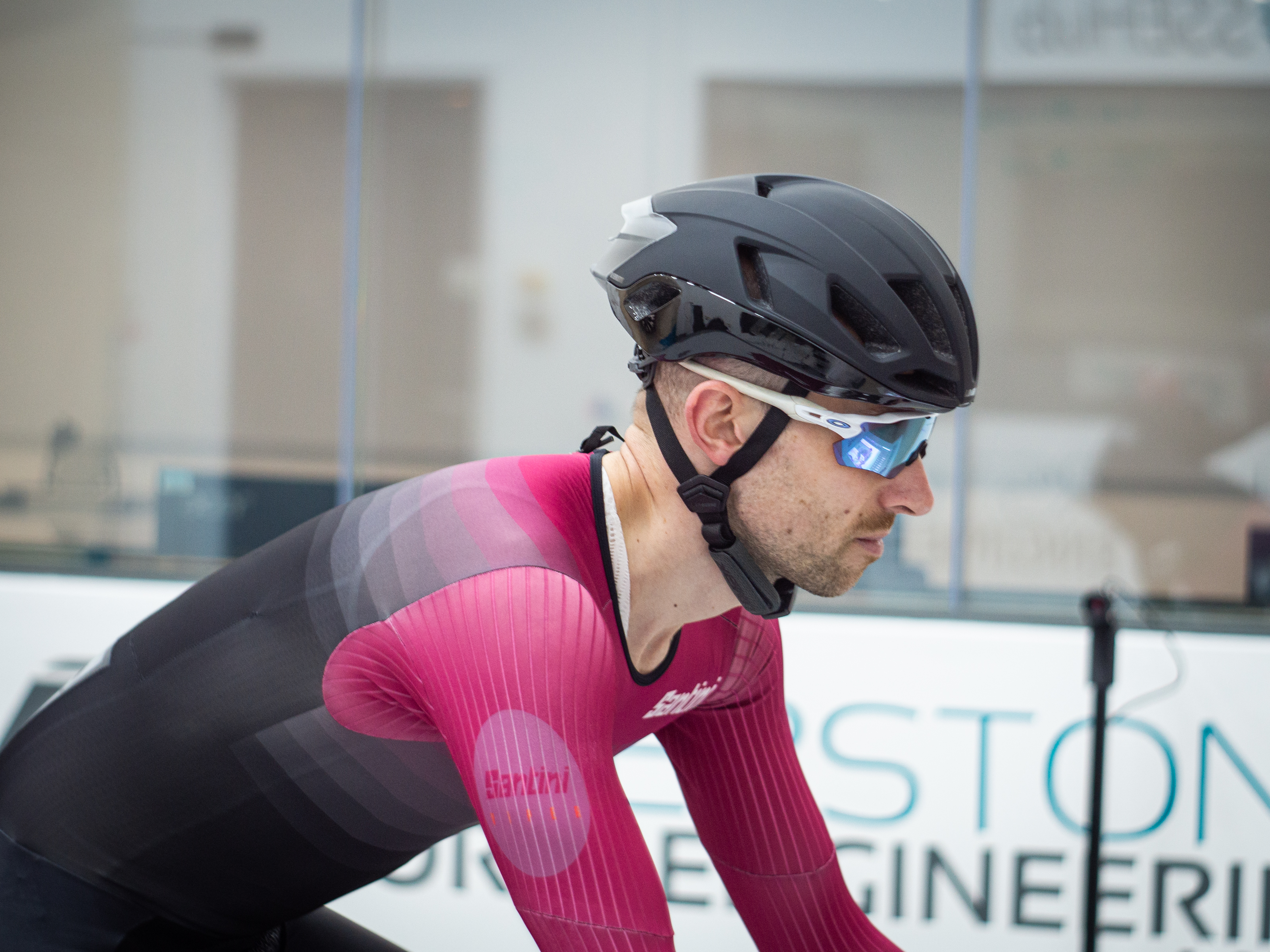
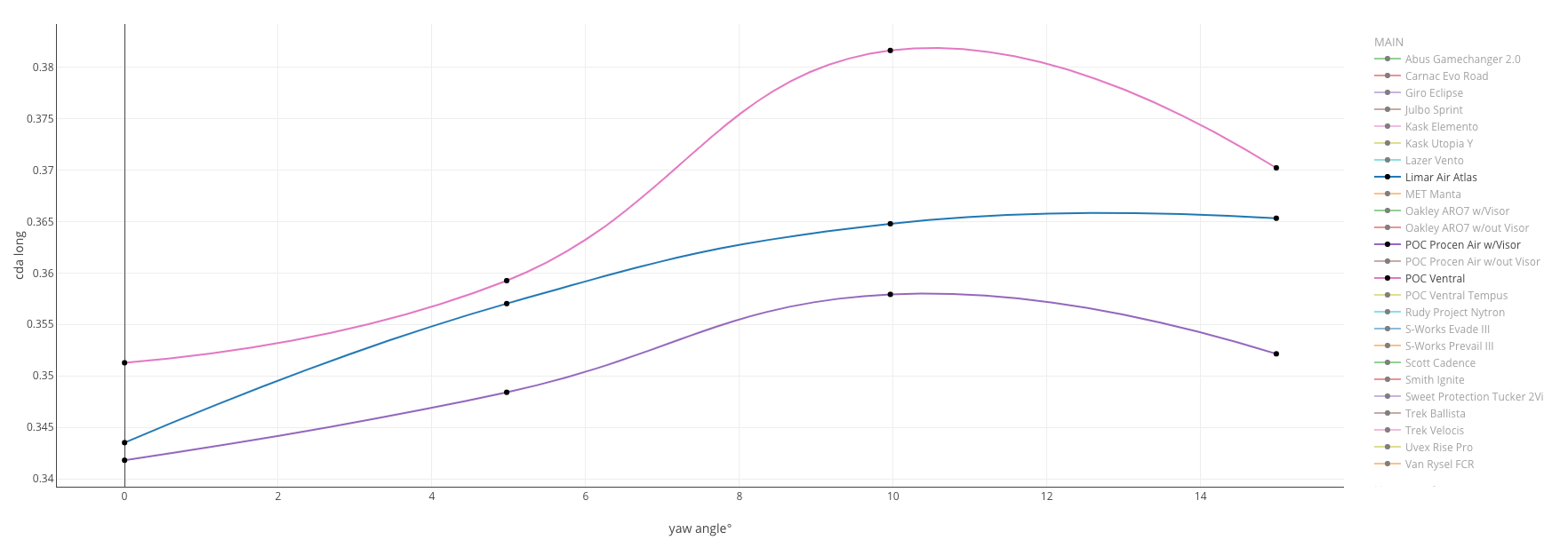
We're definitely getting more into the realm of all-rounder helmets now, rather than dedicated aero lids, but the Air Atlas is still touted as a go-faster helmet by Limar, so the brand might be a little disheartened by our results.
This is the helmet you'll find atop the head of many of the Astana Qazaqstan riders, and as such, the man who kicked off aero helmets all those years ago, Mark Cavendish (he wore a helmet with an aero shell to cover the vents when winning the World Championships in 2011).
With Cavendish in mind, for a bit of fun, I calculated a 200-metre sprint – at a flat average of 1500 watts – in the POC Procen Air (with visor) against the Limar Air Atlas. With everything else equal, by the time the Procen Air had completed the 200 metres, the Air Atlas would be 1.43 metres behind – a definite winning margin.
17. Abus Gamechanger 2.0
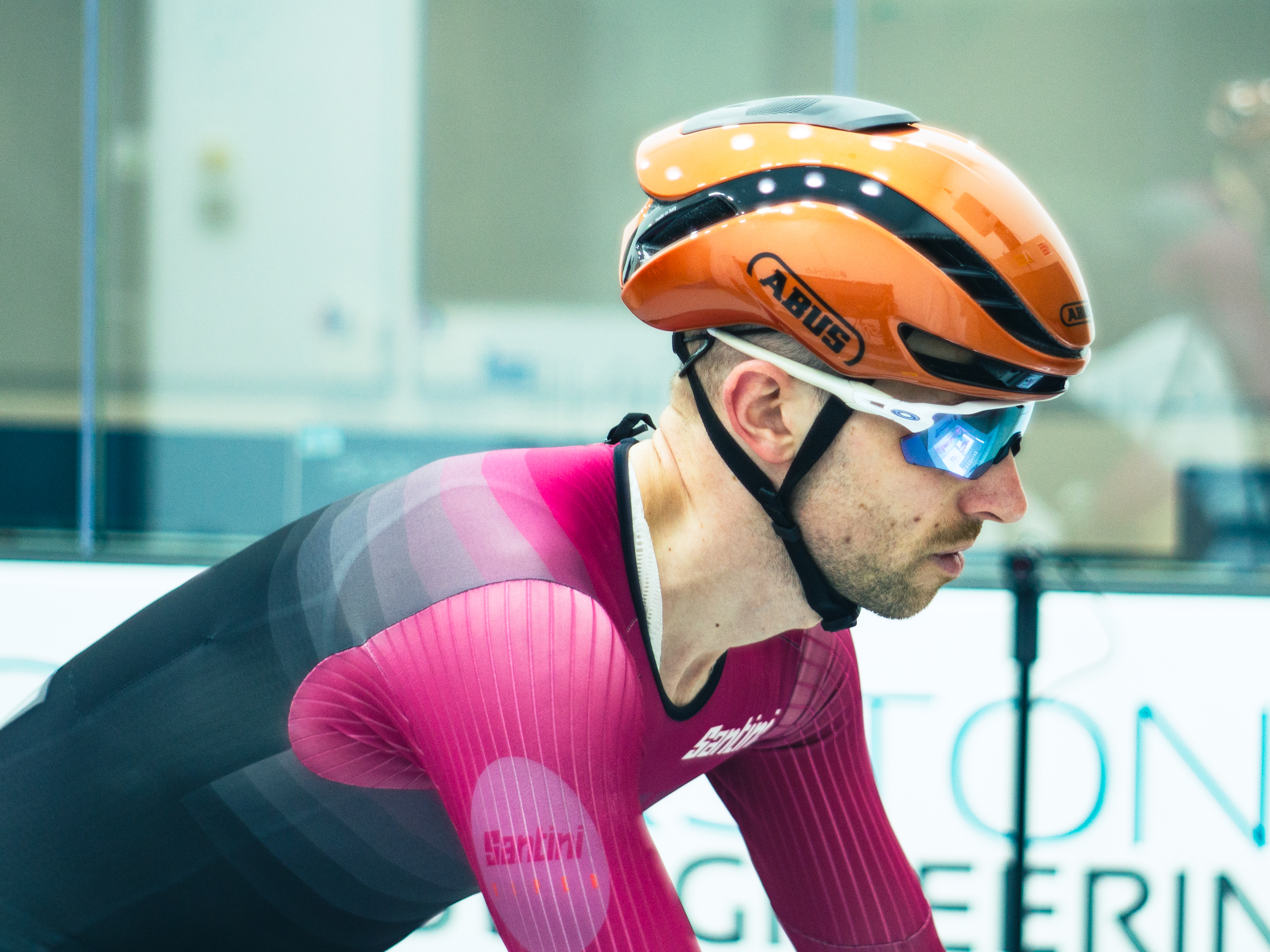
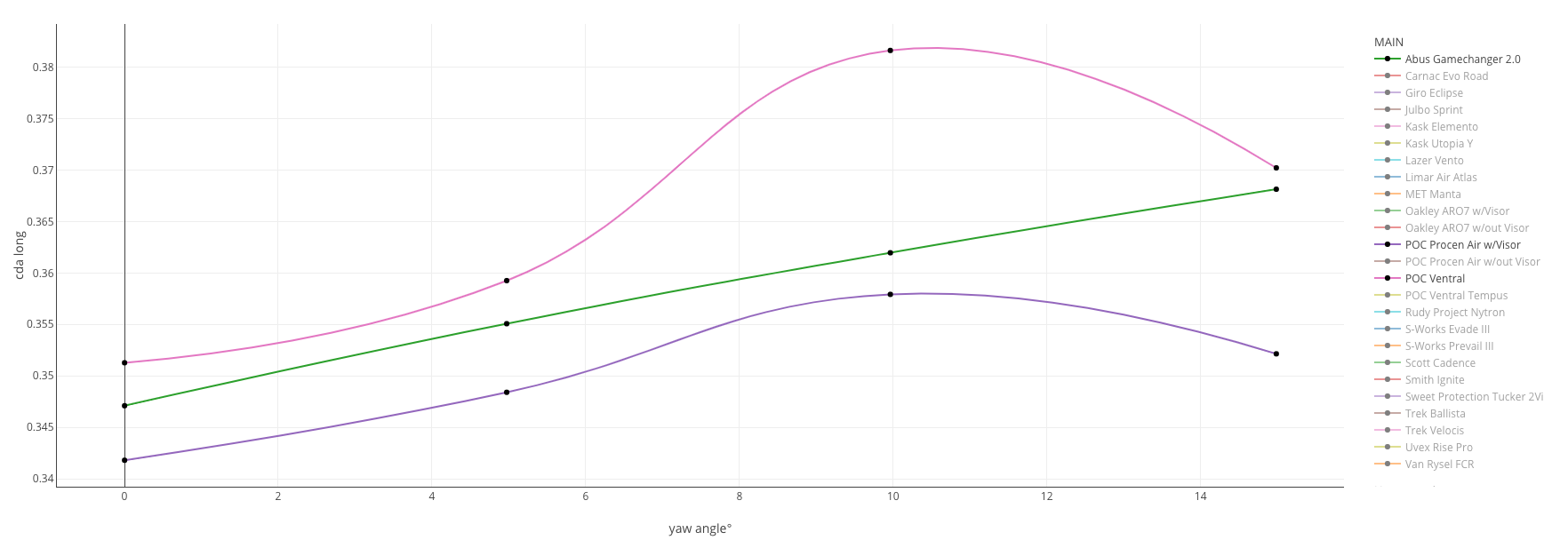
The very helmet used by Mathieu van der Poel, the Gamechanger 2.0 helmet is a definite aero-first helmet, so the results here were a bit of a surprise.
I have personally had a great experience using, racing and generally owning the original Gamechanger helmet, and the 2.0 appears to be an improvement on that, but in this particular test, it didn't perform as well as we'd have thought, losing around 6.6 watts against the Procen Air.
18. Oakley ARO7 w/out Visor
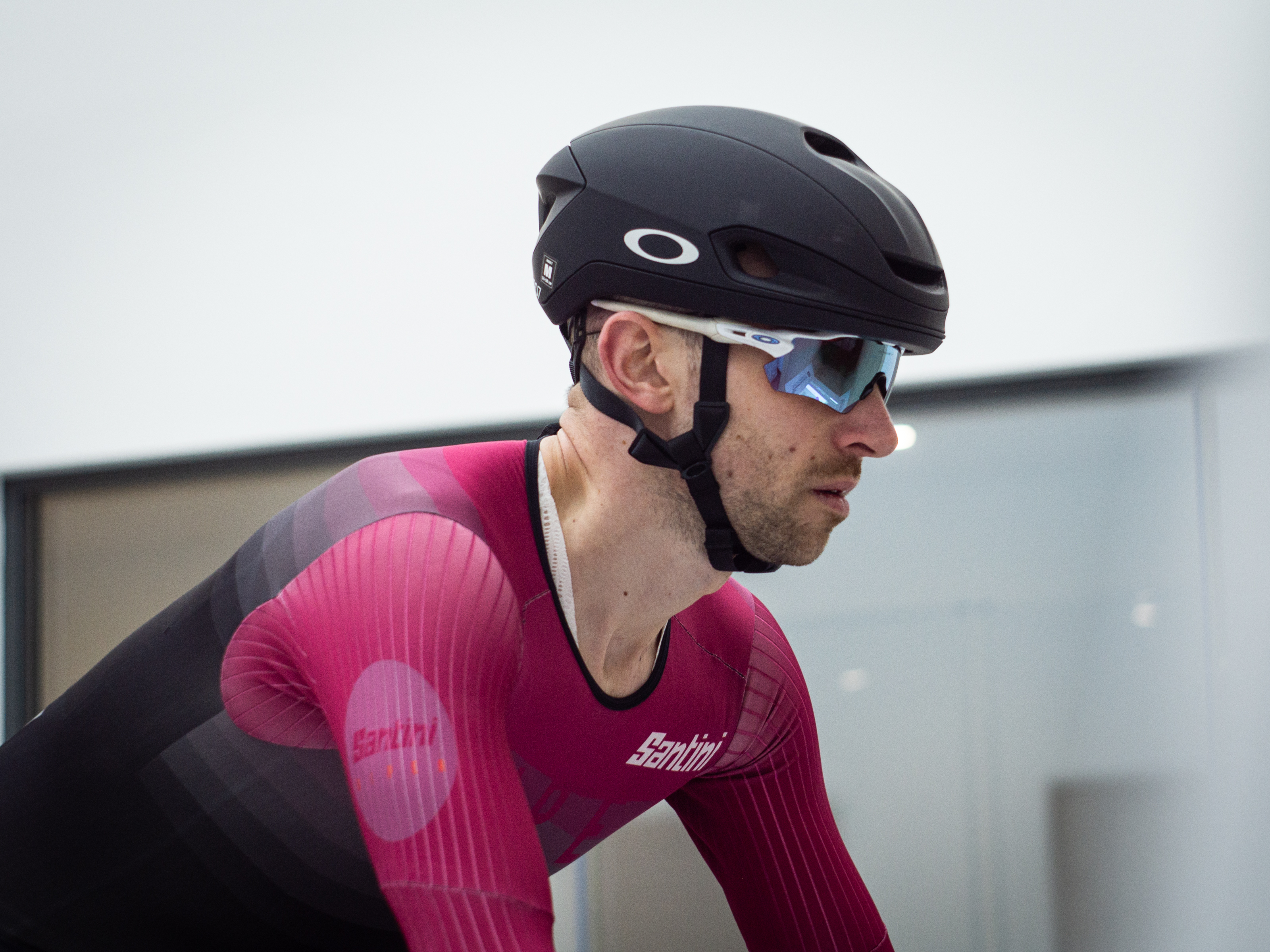
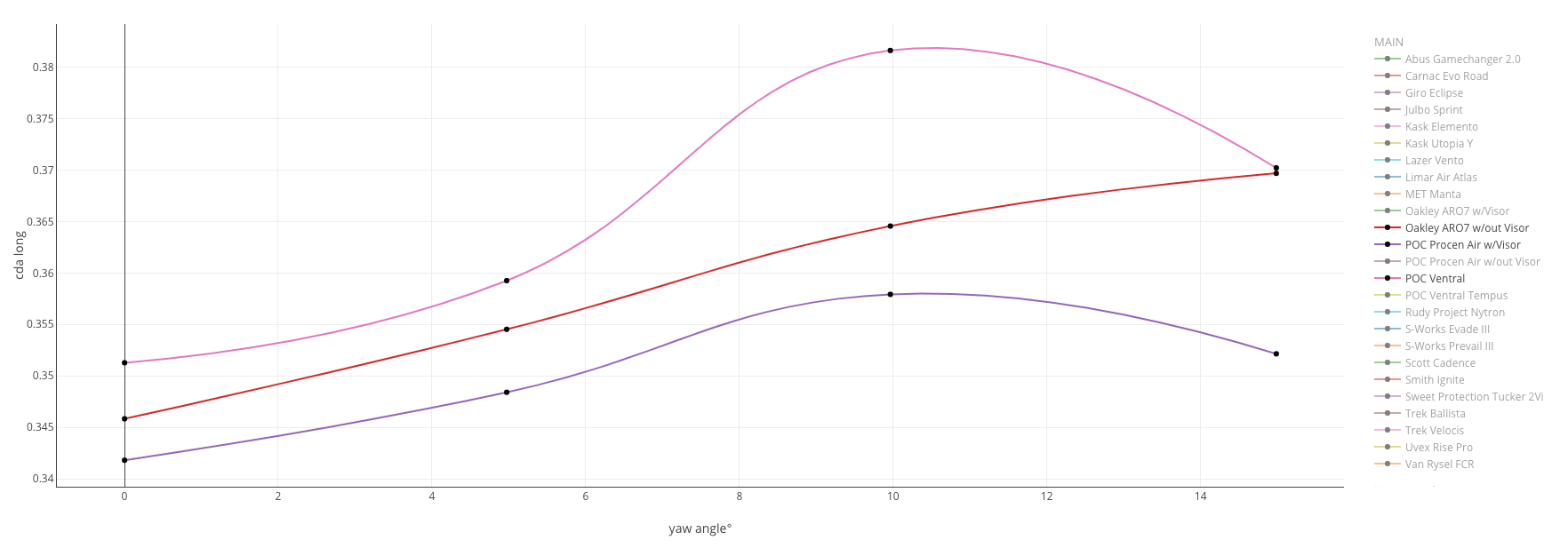
If you worry about looking silly in the Procen Air – you and me both – then the Oakley ARO7 takes the prize. Carrying more of a commuter helmet aesthetic, the ARO7 is chunky, and although that does add to the sense of protection, it unfortunately also adds to the drag coefficient.
Notably, unlike the Procen Air, this helmet is faster without the visor than with it, but in both guises, it's still firmly in the bottom third of our table, and would require exactly seven more watts to hold 40km/h.
19. Carnac Evo
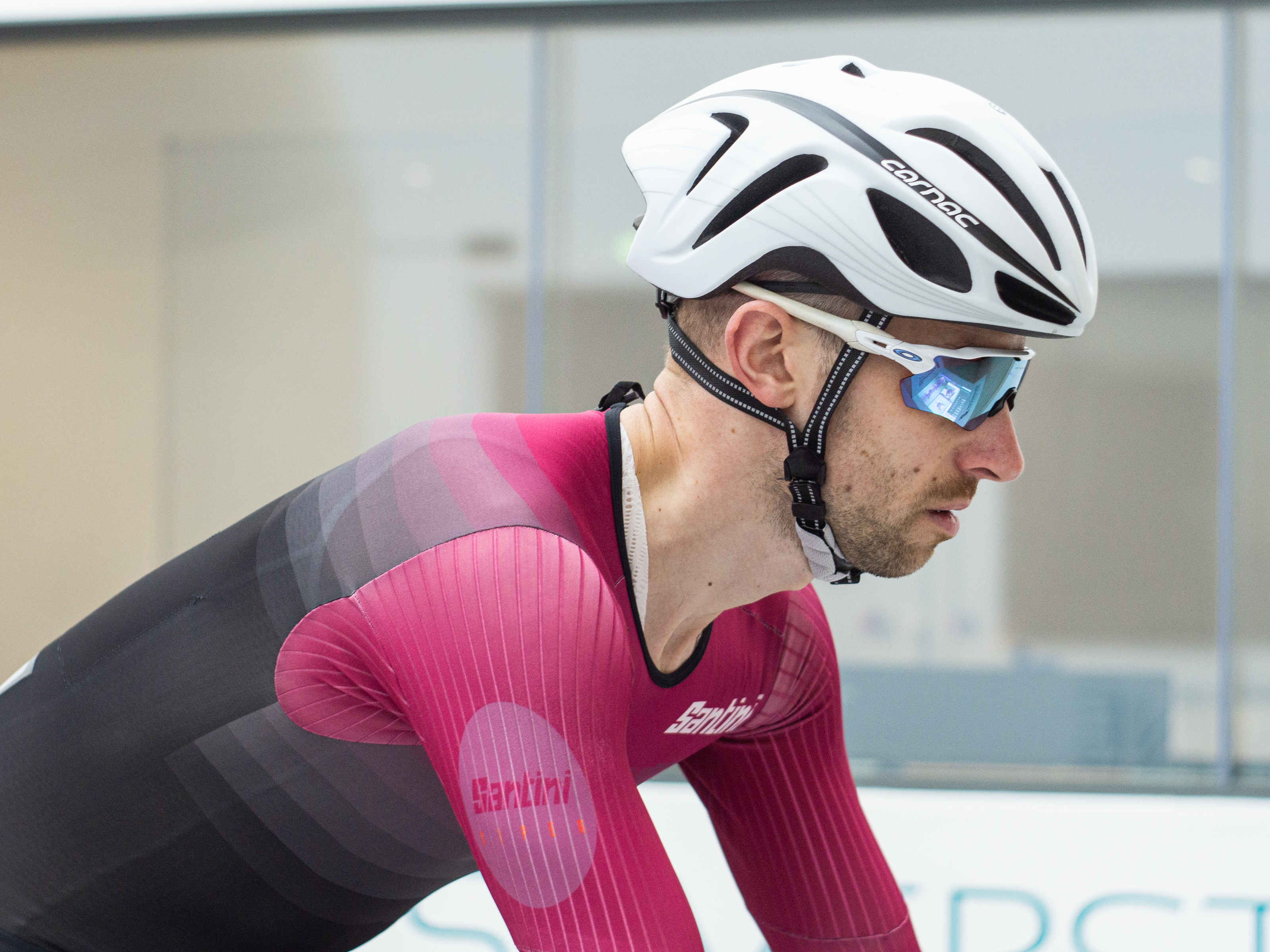
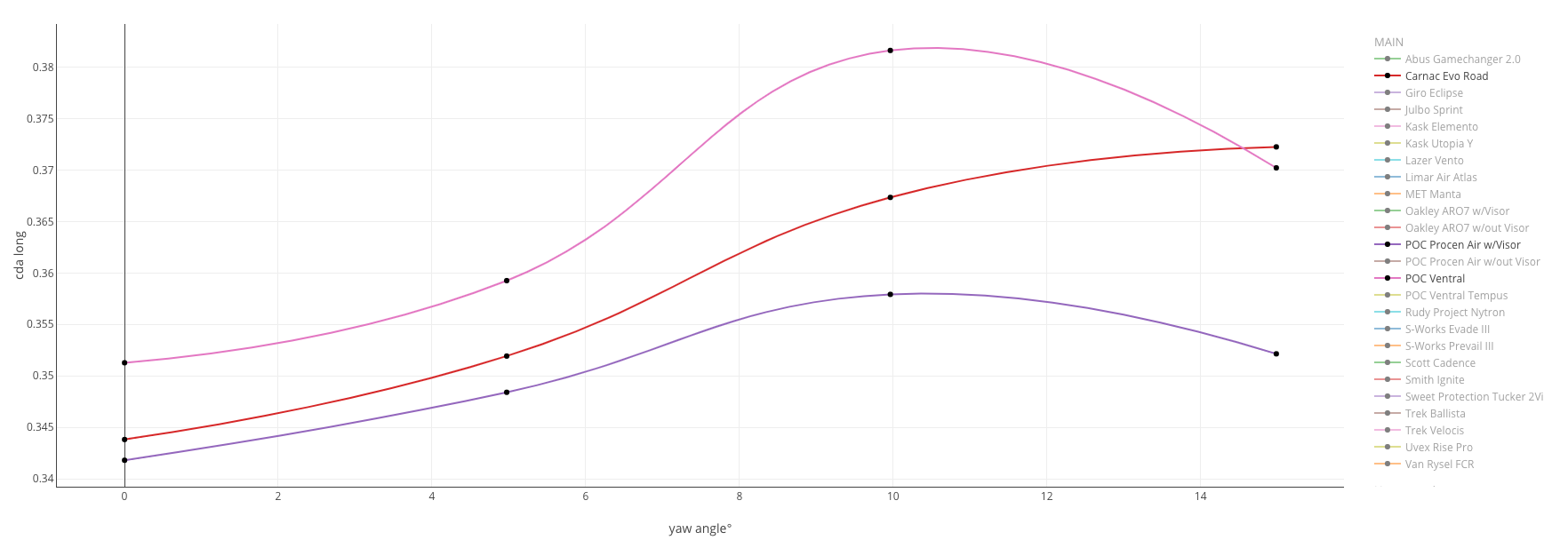
The Carnac Evo is our leftfield inclusion, because unlike all the other helmets here that cost a not-insignificant sum of money (the cheapest being the Van Rysel at £89.99), this one cost just £19.99 plus shipping.
We included it because we wanted to see what the difference between 'cheap' and 'expensive' are, and see whether spending hundreds of pounds/dollars/etc is actually necessary.
The answer, unfortunately for those of us on a shoestring budget, is yes on multiple counts. Aerodynamically, it's not the slowest helmet on test, but it's certainly one of them. At low yaw angles, the Carnac Evo does stand up well against the competitors, but once the wind angle grew, its CdA rocketed.
However, there are a couple of big caveats to this learning. Firstly, anyone who's been around for a few years will see this the resemblance of the original S-Works Evade helmet here. I'm not here to speculate on how the design came to find its way into a Carnac helmet, but the reality is, Specialized knows how to make an aero helmet, so this is perhaps not the fairest representation of your generic 'cheap' helmet as a comparison to the expensive models.
The second caveat is that the quality of the helmet's construction feels in line with the low price tag. For example, upon removing it from its box, a large piece of surplus EPS foam broke off in my hands, and upon trying it on, there were two significant pressure points between the top of my head and the helmet. Of course, your mileage may vary, but I would recommend trying before you buy.
20. Specialized S-Works Prevail III
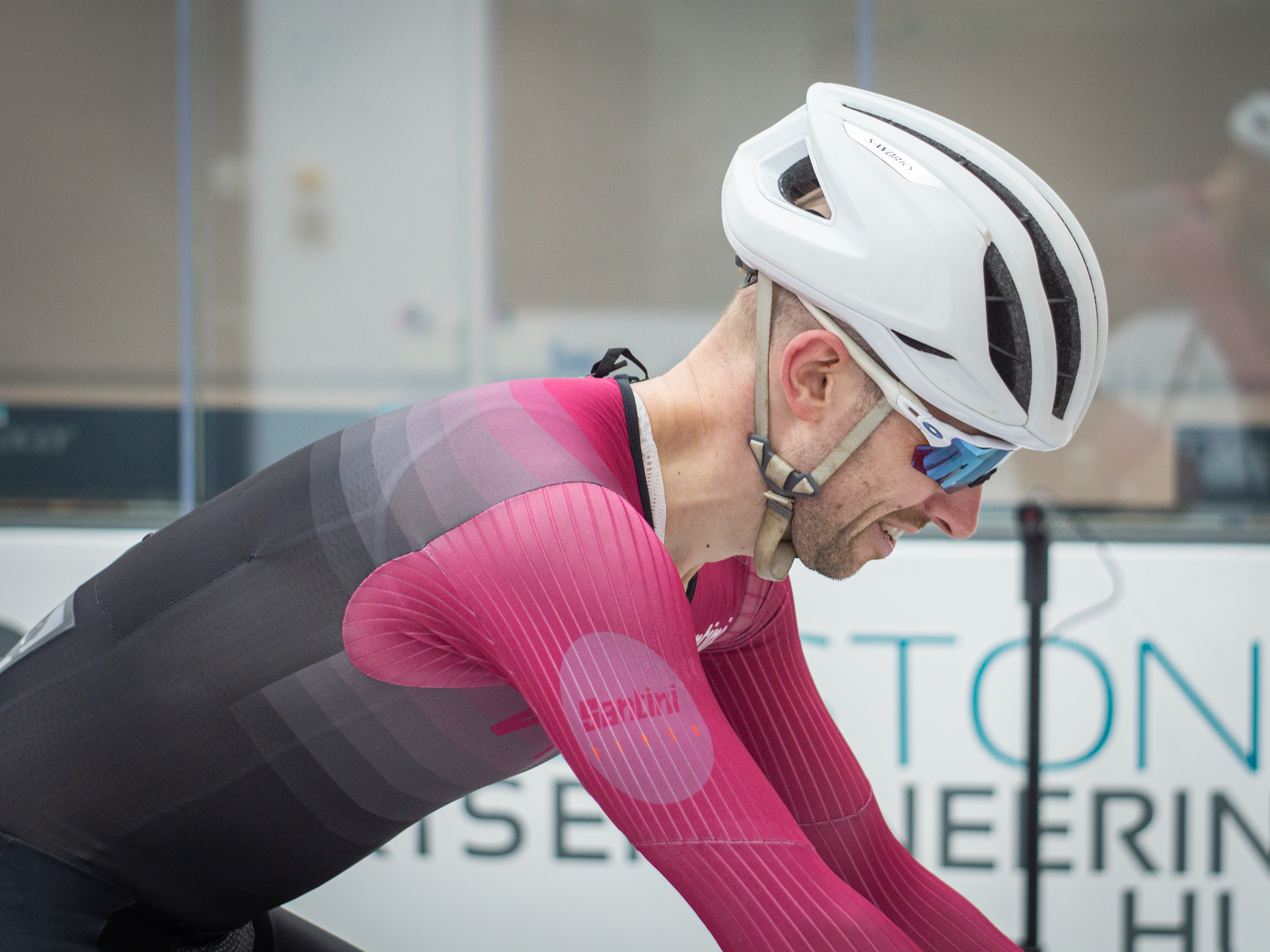
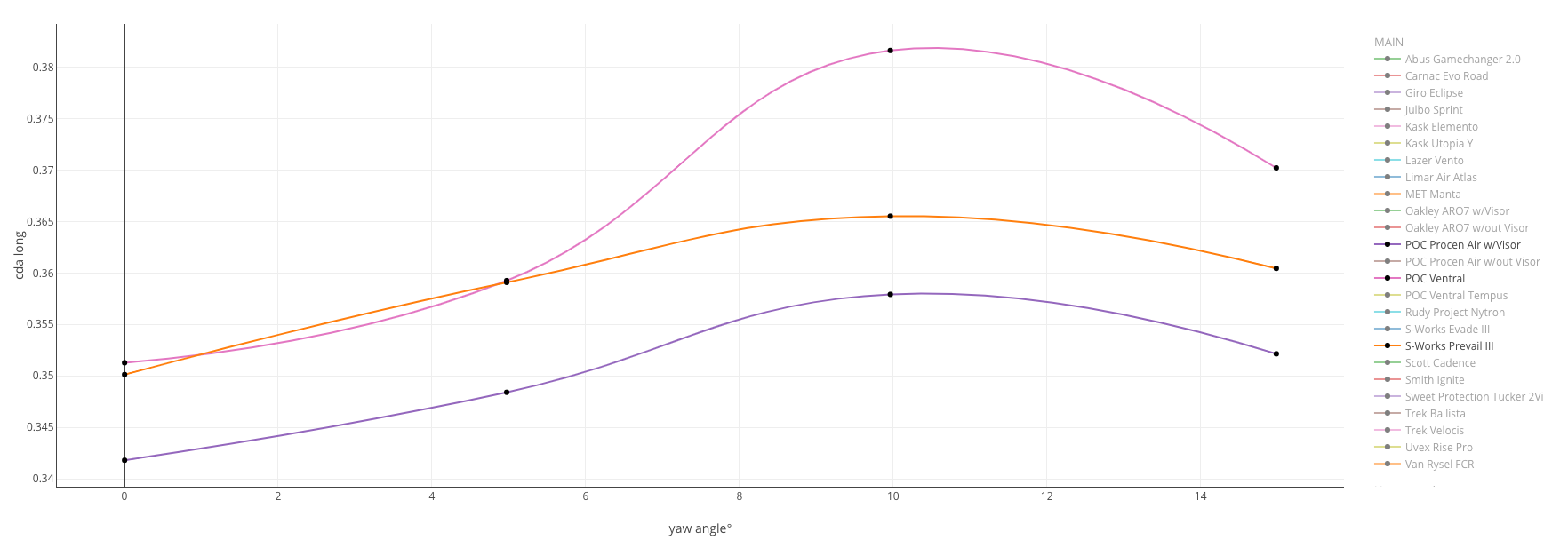
Another leftfield inclusion here, the S-Works Prevail III is anything but an 'aero' helmet by design, with huge gaping vents up front.
Why include it then? We wanted to get a feel for the difference between an 'aero' helmet and an 'airy' helmet, to see what gains you get when you make such a switch. The answer, in the case of the S-Works Prevail III against the S-Works Evade III, is 24 seconds over 40km when riding at 250 watts.
Thinking of a sprinter, if the likes of Tim Merlier were to choose the Prevail instead of the Evade, they'd be giving away 1.22 metres in a 200-metre, 1500w sprint. Things get a bit more complicated when the temperatures climb, though, because the Prevail is much cooler (temperature-wise; I'm not the best judge of fashion) and a cooler core temperature could result in better power output, which offsets the aero gain multiple times over.
21. Rudy Project Nytron
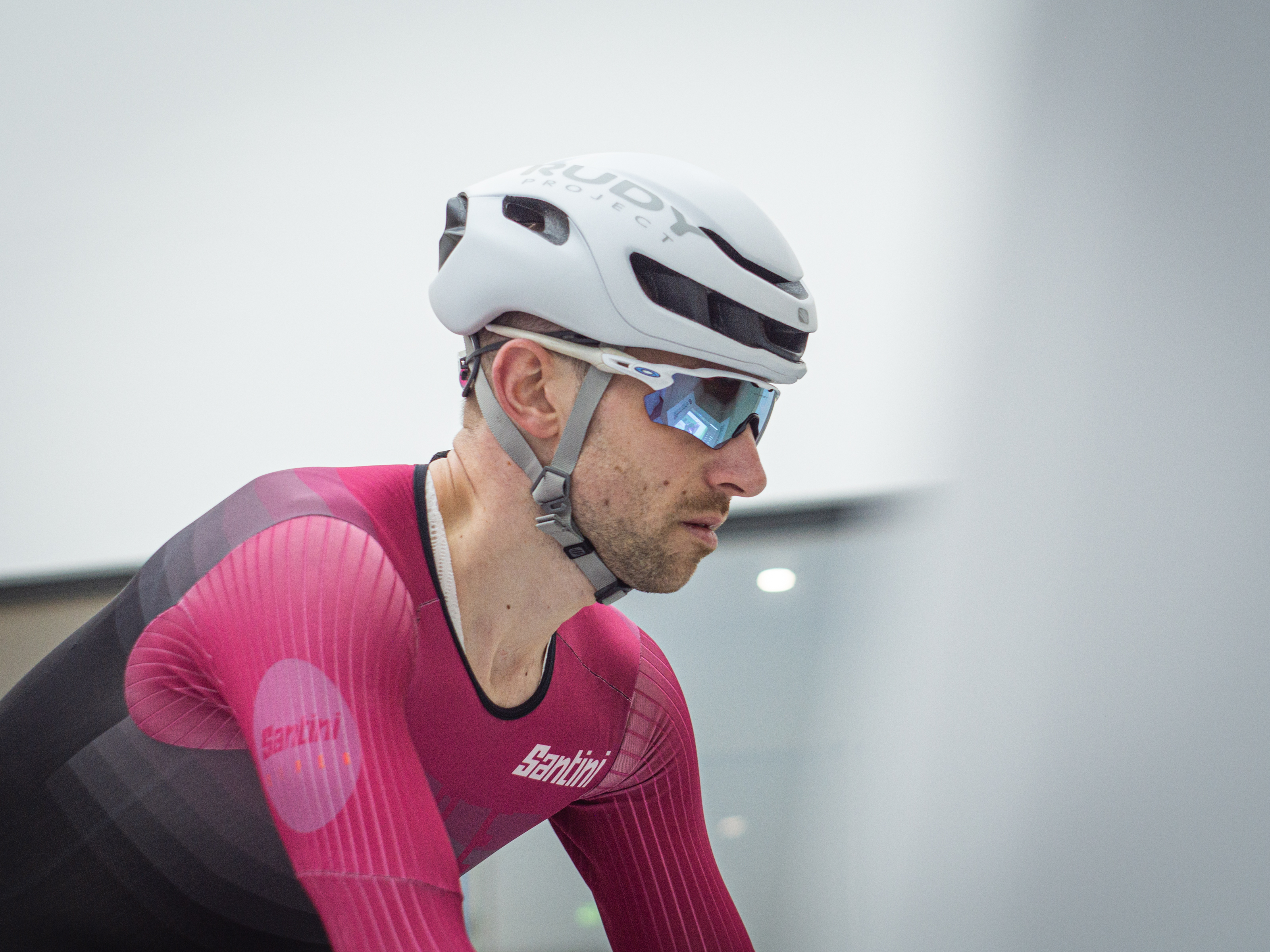
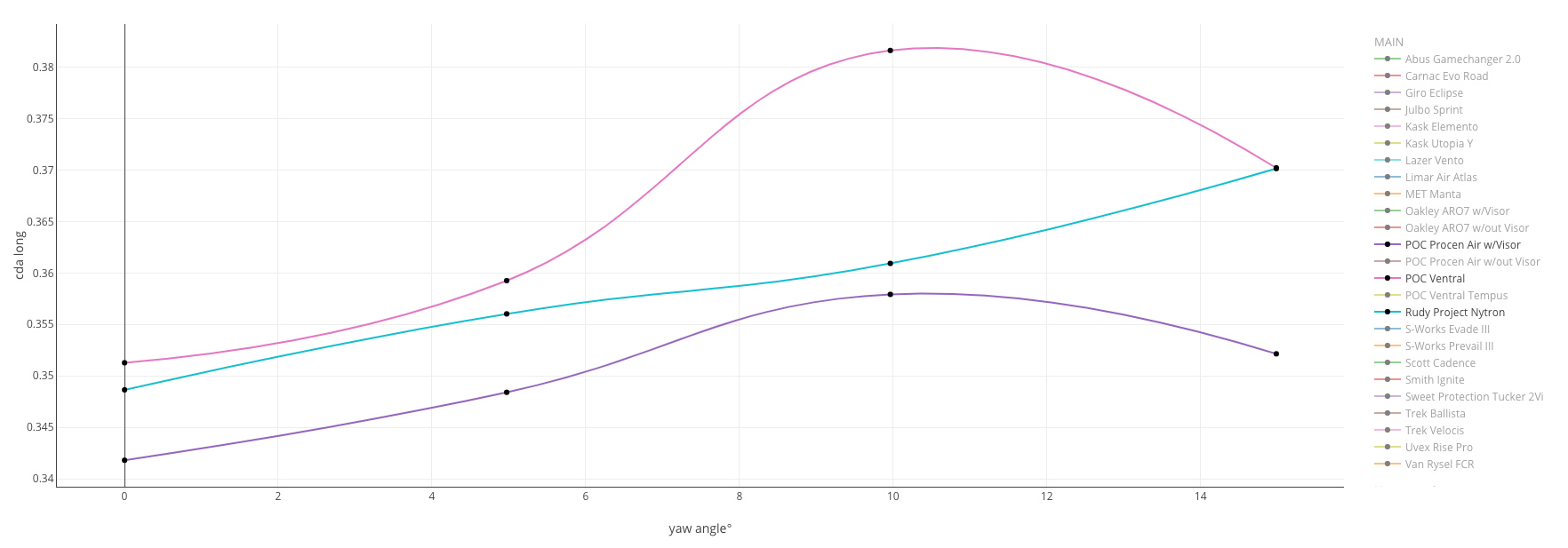
We're getting into the final few now, and interestingly, despite this pretty poor result, Rudy Project says its Nytron helmet was developed in a wind tunnel with help from aero experts Swiss Side. It's unclear exactly what input Swiss Side had, nor what tests were used in the development, but I'm not one to doubt their credentials.
Instead, let this be a reminder that our data is simply a reflection of our tests – not the final word on performance – but aims to provide an impartial stream of data against a backdrop of wider context, that can hopefully help our readers.
With that said, at 40km/h, 7.24 watts separate the Nytron and the Procen Air, while a still significant 5.51 watts separate it from the slowest on test.
22. Oakley ARO7 w/ Visor
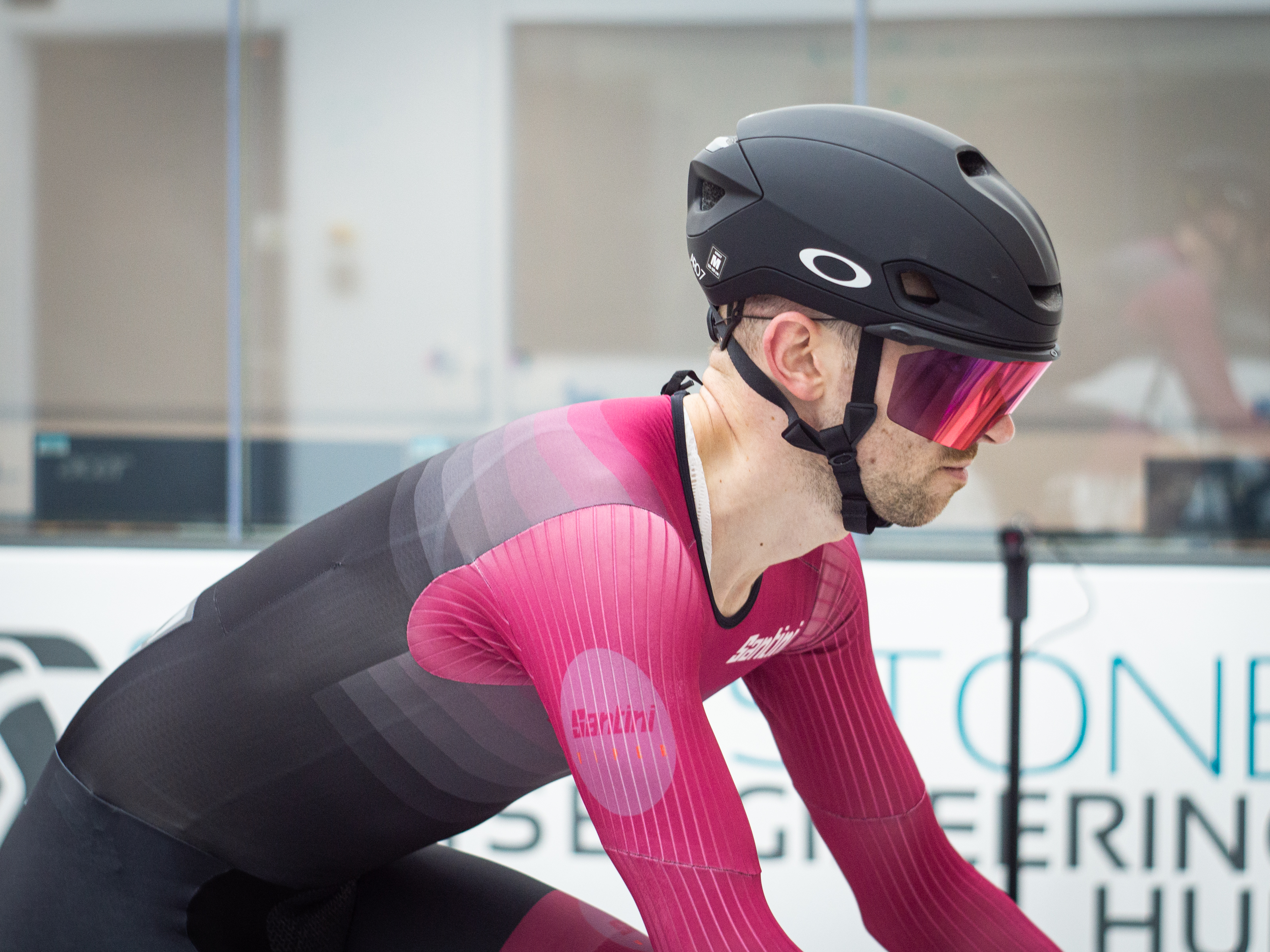
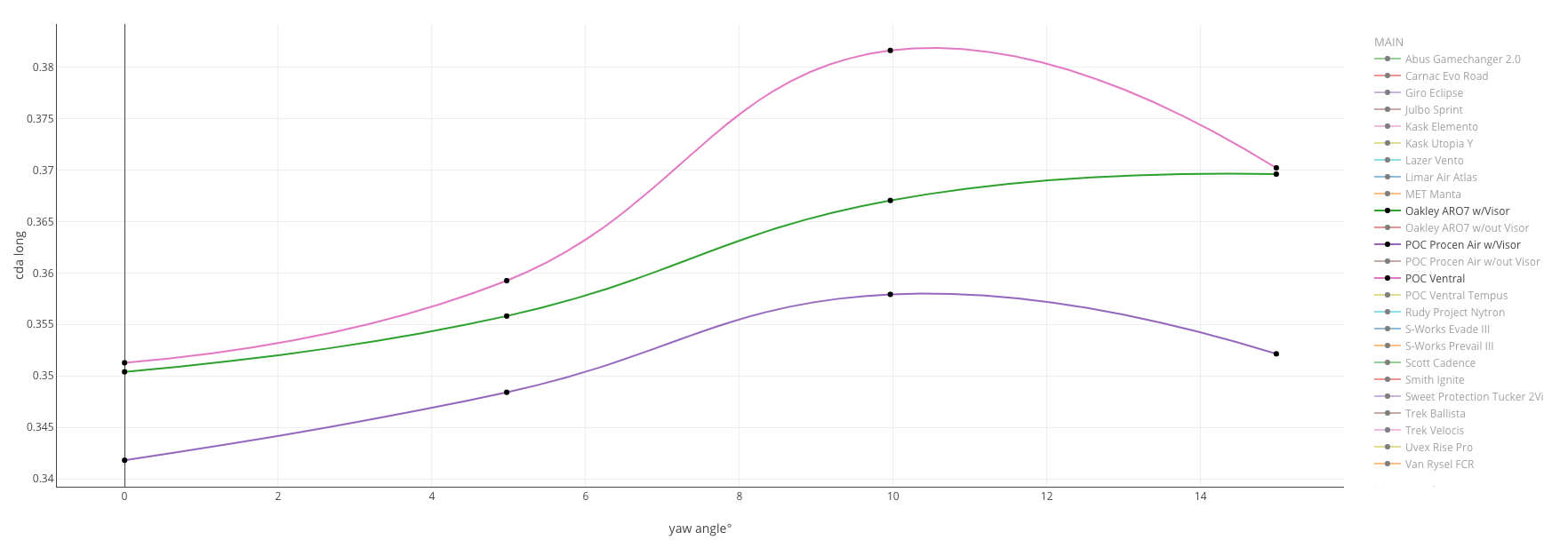
We've already touched on the ARO7 above, and here we get the result of the same helmet with the visor attached, scoring an average CdA of 0.3607. The visor itself is quite a sizeable thing, it curves laterally around the head, but doesn't really curve in the vertical plane, meaning it provides quite a large surface area to catch the wind and add drag to your ride.
23. Uvex Rise Pro
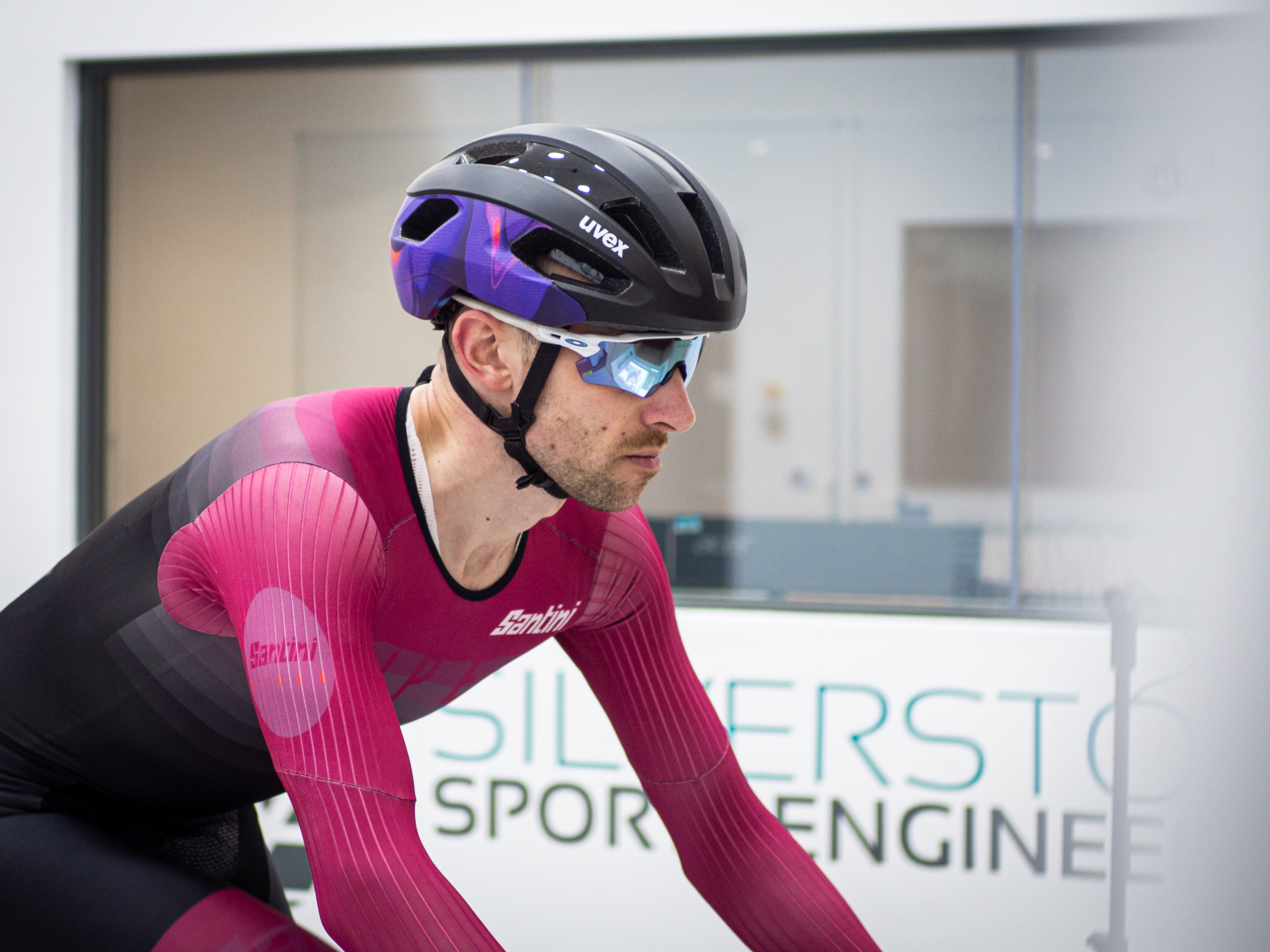
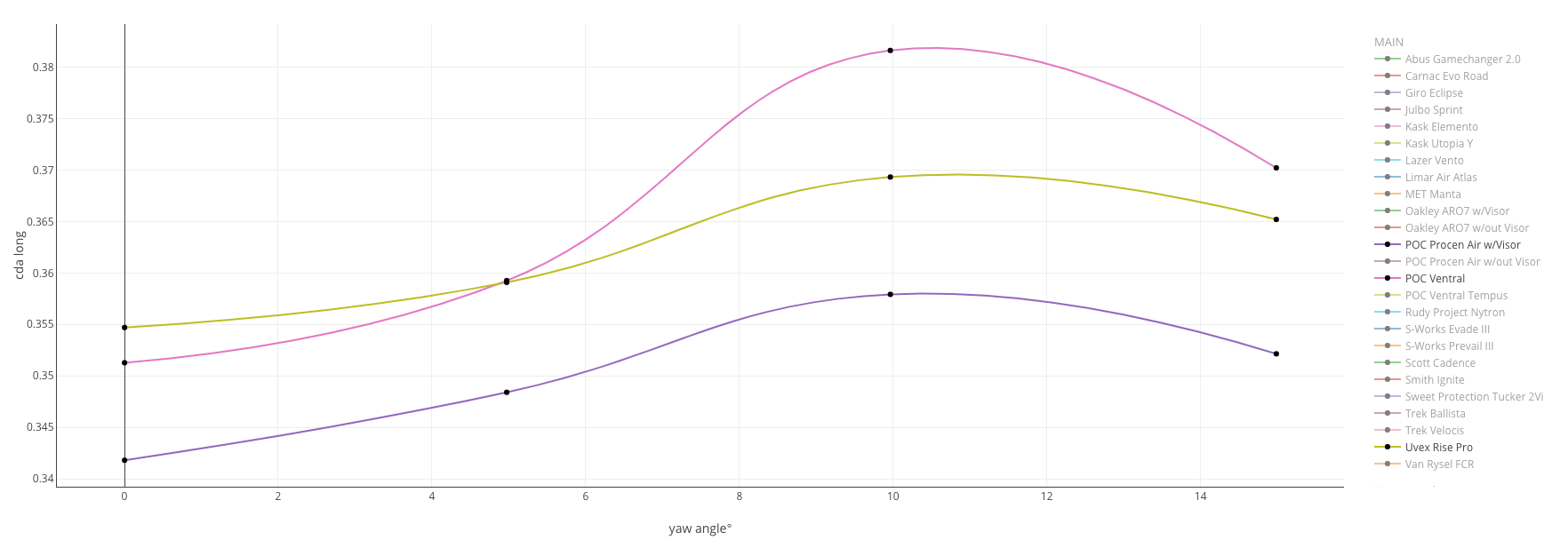
Uvex is the helmet you'll see atop the heads of the Intermarché-Wanty 2024 team. It's very evidently an all-rounder helmet rather than a dedicated aero lid, but we chose to include it because we wanted to include as many of the WorldTour sponsors' helmet options as possible.
Naturally, the likes of Biniam Girmay and co will be disheartened to see that - in our tests - they're giving away around eight watts at the traditional racing speeds (40km/h) and more as the speeds grow, but with five wins and a handful more podiums under their belt so far this season, it doesn't seem to be harming them too much.
24. POC Ventral Tempus
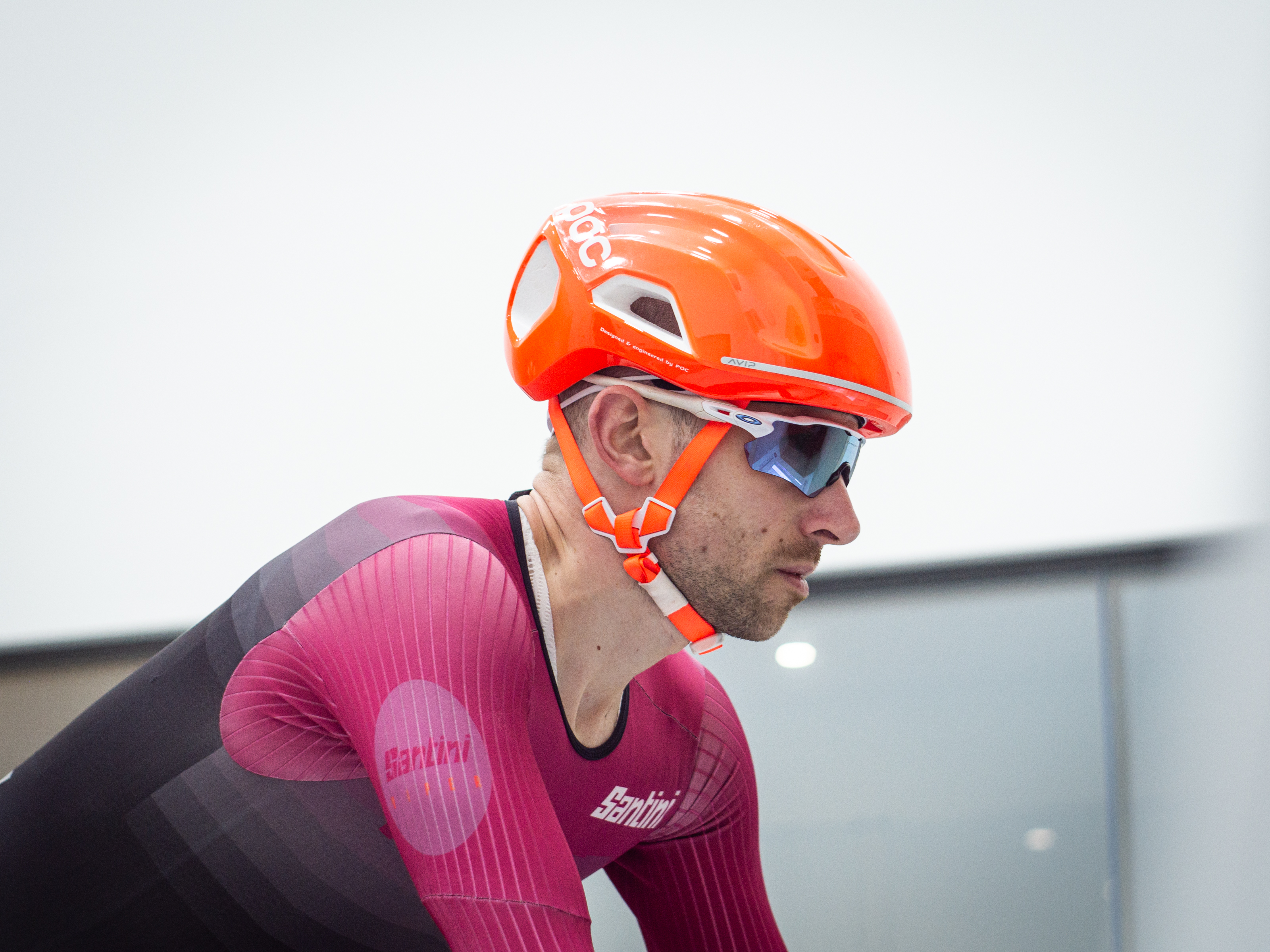
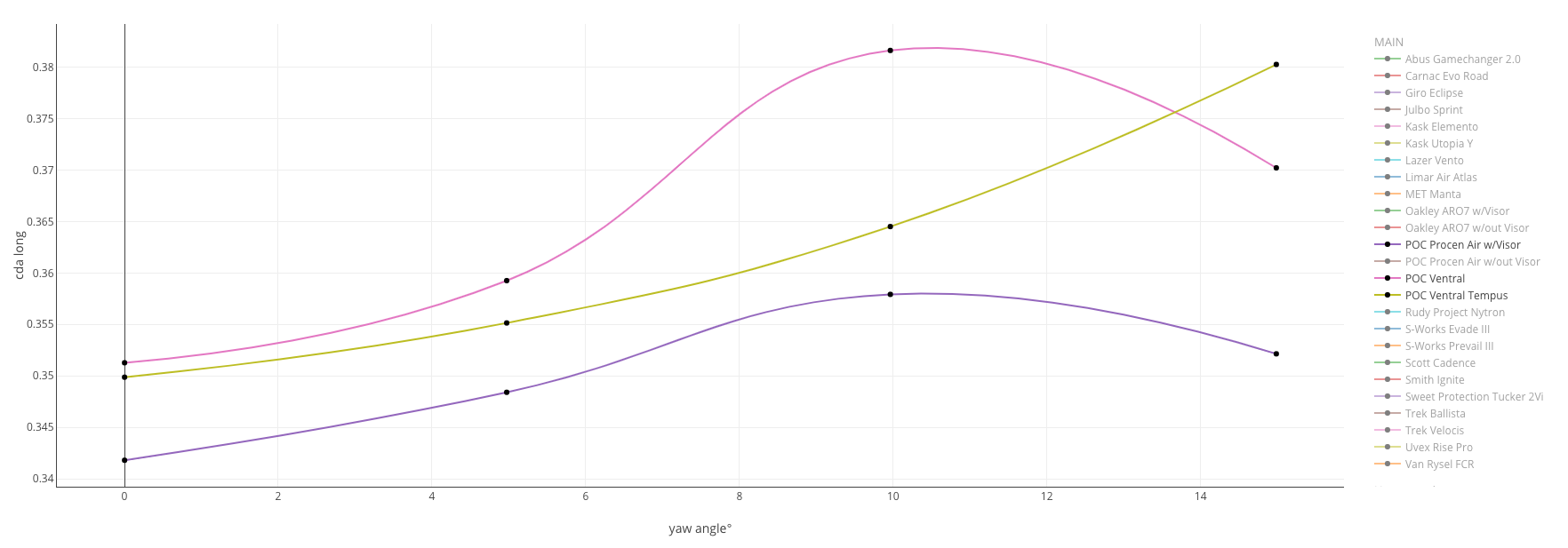
Interestingly, while the winner of this test is POC with the Procen Air (visor), the Swedish brand also finds itself at the bottom too, with the Ventral Tempus and the standard Ventral, below.
Focussing on the Tempus for a second, the performance here held a solid mid-table result at lower yaw angles, before ballooning at a 15-degree wind angle. This is perhaps due to the unconventional approach of simply taking an existing helmet and adding a cover.
It's worth saying that the Ventral Tempus isn't first and foremost an aero helmet. It was created as a helmet for bad weather in response to the UCI banning add-on helmet covers, which pro riders tended to do in the rain.
The theory was that adding the cover also benefitted the aero performance, and while that's proven true, it's not by much, with a saving of 2.6 watts.
25. POC Ventral


It'll be mixed feelings for the Swedish brand, POC, whose Procen Air helmet lands squarely at the top of this test, while the Ventral lands at the very opposite end.
There has to be a loser though, and last, but by no means least, comes the brand's former flagship aero model with an average CdA of 0.3656. Although, it was never a die-hard aero helmet, and more a refined version of the POC Ventral Air all-rounder.
Looking at the graph, like the Ventral Tempus, it held a reasonably decent performance at the lower yaw angles, before stepping up in a big way at 10 degrees. Interestingly it came back into the realm of the competitors at 15 degrees.
Interestingly, at the launch of the Procen Air, POC said it saved 18 watts at "racing speeds," which it positioned at 30 to 60km/h. We've got the CdA here, so running the maths between the two helmets, you get a difference of 5.38 watts at the relatively sedate 30km/h, and a huge difference of 43 watts at 60km/h, with the caveat that at those speeds, the yaw angle would be consistently close to zero, and the rider position would need to be significantly more aerodynamic than our relaxed, relatively upright testing position.
The conclusions
There we have it, 23 helmets, 25 tests, and a whole heap of numbers for data nerds to feast upon, but what did we learn?
1. You don't have to be a pro to make savings
While we did the test at 40km/h, it's the power differential at slower speeds that I think stand out more. Riding at 40km/h on your own will be tough. Not unfeasible for an amateur racer, but tough. When you do ride that fast, you'll probably be riding in a bunch, where the aerodynamic importance is reduced by the reduction in wind force. While an aero helmet is still beneficial, the real-world difference will be smaller than if you were in a time trial or a solo breakaway.
However, most keen amateurs will be able to hold 30km/h for extended periods of time, and the difference on offer here at that speed is around 5.4 watts. For someone with a 270-watt FTP, that's a 2% bump in performance simply by swapping helmet. That's significant, and a saving that most amateurs will be able to get.
With that said, a pro rider in a breakaway at 50km/h stands to save nearly 25 watts between the POC Ventral and the POC Procen Air. The one caveat here is that we're using CdA data pulled from a relaxed riding position rather than an aero-hoods breakaway position, so it's not perfectly transferable, but POC-sponsored EF riders should still take note.
2. Helmets save more than wheels
Some of you might recall that we went to a wind tunnel back in 2022 to test mid-depth road wheels. The winner of that test was the DT Swiss ARC 1100 Dicut, at 62mm deep. Compared to the slowest on test, they would save you 3.87 watts at 40km/h. Those wheels are in the region of £2,300, while the 2nd place Hunt Limitless 60 wheels were 1.9 watts slower and around half the price.
Of course, if you put your money into some new wheels, there might be other benefits like weight, and improved tyre interaction which can lead to improved grip and rolling resistance. Alternatively, you could spend less than 10% of that cash on a helmet and get significantly greater aerodynamic gains. Who's saying you can't do both?!
As always, the gains on the table are totally dependent on what you're starting with, so common sense shall prevail.
3. Aero design isn't always aero
On visual inspection, comparing the Rudy Project Nytron with the Specialized Prevail, and everyone would assume the Nytron is the faster helmet. It has a closed-off front with just a couple of vents, while the Prevail is arguably more vent than helmet, but the results speak for themselves. It's a notable trend throughout our results. The all-rounder Giro Eclipse eclipsed (pun very much intended) dedicated aero lids like the Sweet Protection Tucker, and the Trek Velocis was only a fraction slower than its aero stablemate the Ballista.
I think on the balance of averages, the aero design does win out overall, but don't assume that just because it looks aero, it actually is.
4. Sort out your straps
On researching for this article, I met with a helmet designer who spoke about the aerodynamic and safety penalty of loose helmet straps. You could spend hours toiling over choosing which helmet to buy, only to undo all the gains by having a strap that flaps in the wind. From a safety standpoint a properly fitted strap makes sense, even if you don't care about aero gains.
5. Don't negate fit
The last takeaway is more of a PSA than a learning, per se, but an important one nonetheless. You are buying a helmet because wearing one is safer than not wearing one, and an ill-fitting helmet isn't safe.
If a helmet saves you six watts, but doesn't do its primary job of protecting you in a crash, those six watts might quickly seem incredibly trivial, so when you're buying a helmet, feel free to use these numbers as a guide, but not as gospel. If a helmet doesn't fit, feels a bit wobbly, or blocks your vision, try another one that does.







